Search Results
Released March 7, 1988. The first record contains the original version of “Love Me Do” with Ringo on drums, together with both the A and B sides of a further four singles “From Me To You”, “She Loves You”, “I Want To Hold Your Hand” and “I Feel Fine”, together with their respective B sides of “Thank You Girl”, “I’ll Get You”, “This Boy” and “She’s A Woman”. Other tracks on the Record One are “Komm, Gib Mir Deine Hand” and “Sie Liebt Dich” originally issued in Germany as single. “Long Tall Sally” and “I Gall Your Name” were originally part of the 1964 American “The Beatles’ Second Album”. These, together with “Slow Down” and “Matchbox”, were later issued in Britain on EP. “Bad Boy” originates from the American album “Beatles VI” and was later to be included on the British album “A Collection Of Beatles Oldies”. Finally are included “Yes It Is” and “I’m Down”, that were the B sides of “Ticket To Ride” and “Help!” respectively and were included on the “Help!” album. The version of “This Boy” is the true stereo version originally available only on singles issued in Australia (Parlophone A8103) and Canada (Capitol 72144), and it makes its first appearance on an album here. “She’s A Woman” again in stereo, originates from the 1967 Australian album “Greatest Hits Volume 2” (Parlophone PCSO 7534). “Yes It Is”, in stereo, was issued in Britain in 1986 as part of the “Only Beatles” cassette (Parlophone SMMC 151). Finally, “I’m Down”, in stereo, originally was issued as part of the Japanese “Help!” EP (Odeon EAS 30006). With the exception of “I’m Down”, these stereo versions have been given their first international release on this album.
The Record Two contains “Paperback Writer” that together with “Rain” was issued as a single in june 1966, “The Inner Light”, the B side to the March 1968 single “Lady Madonna”, “Revolution” that was the upside of The Beatles’ first Apple single “Hey Jude” in August 1968, and, finally, “You Know My Name” the B side to their final single “Let It Be” in March 1970.”Across The Universe” originally was included on the charity album “No One’s Gonna Change Our World” issued in 1969.
1. First pressing, March 7, 1988. Unlaminated gatefold black & white outer sleeve with Parlophone logo on the back side. Records are housed in white plain paper inner sleeves.
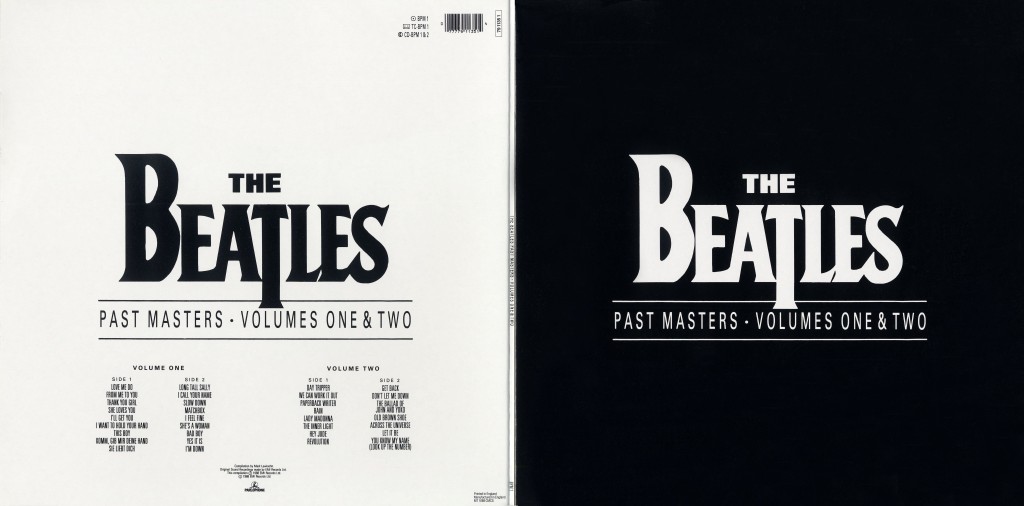
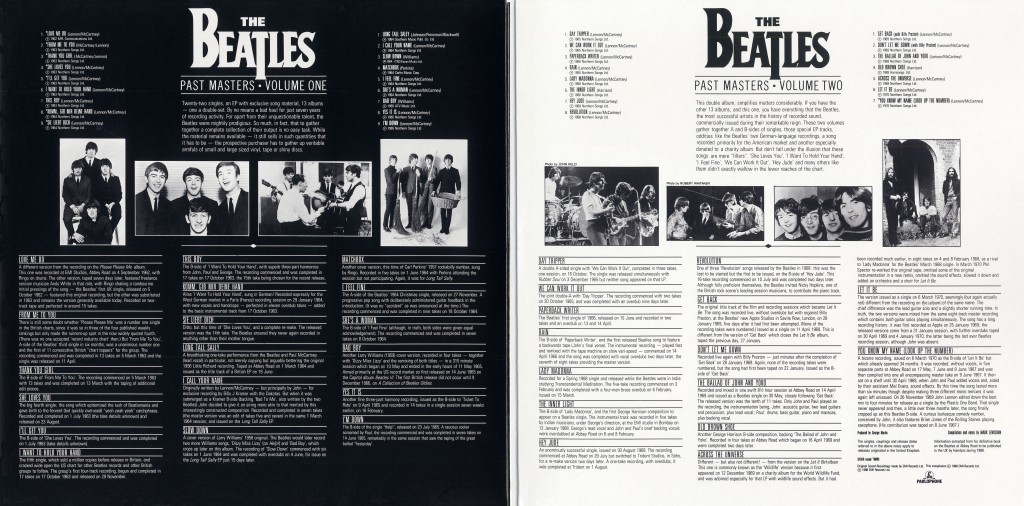
Black label with silver Parlophone logo and silver print. “ALL RIGHTS OF THE PRODUCER” printed at the start perimeter print. Importantly, around the 11 o’clock position in the rimtext the wording is (right to left): “UNAUTHORISED COPYING, HIRING, RENTING, PUBLIC PERFORMANCE AND BROADCASTING”. “MANUFACTURED IN THE UK BY EMI RECORDS” text at the end of the perimeter print. First matrix numbers have the error prefix of the catalog numbers BTM which were scratched out: Record One – Side 1: BPM BTM 11 A-1-1-1; Side 2 BPM BTM 11 B-1-1-1 (or 2); Record 2 – Side 1: BPM BTM 12 A-1-1-1; Side 2 BPM BTM 12 B-1-1-1.




2. Second pressing, 1990s. The gatefold outer sleeve is characterized by the presence of the Apple logo on the back side. Records are housed in white plain paper inner sleeves.
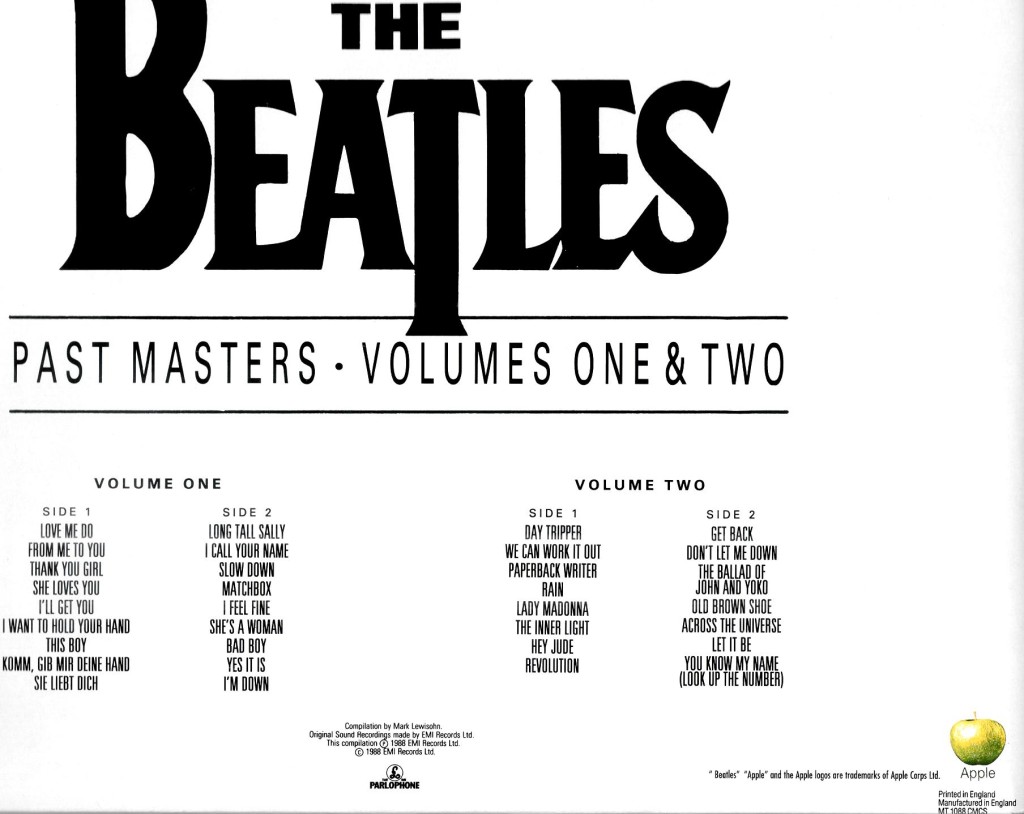
The second pressing has labels as the first pressing. Matrix numbers: Record One – Side 1: BPM 11 A-02-01-1; Side 2 BPMBTM 12 A-1-1-2; Side 2 BPM
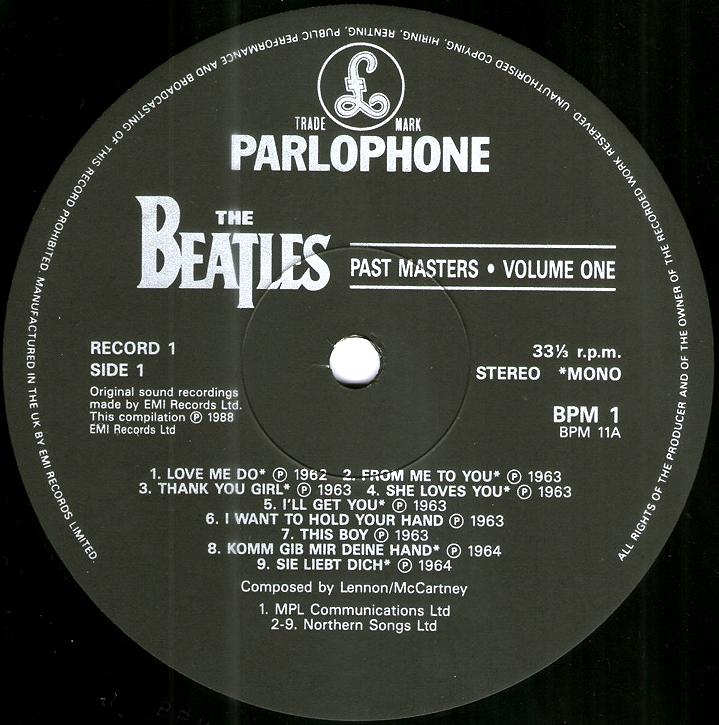
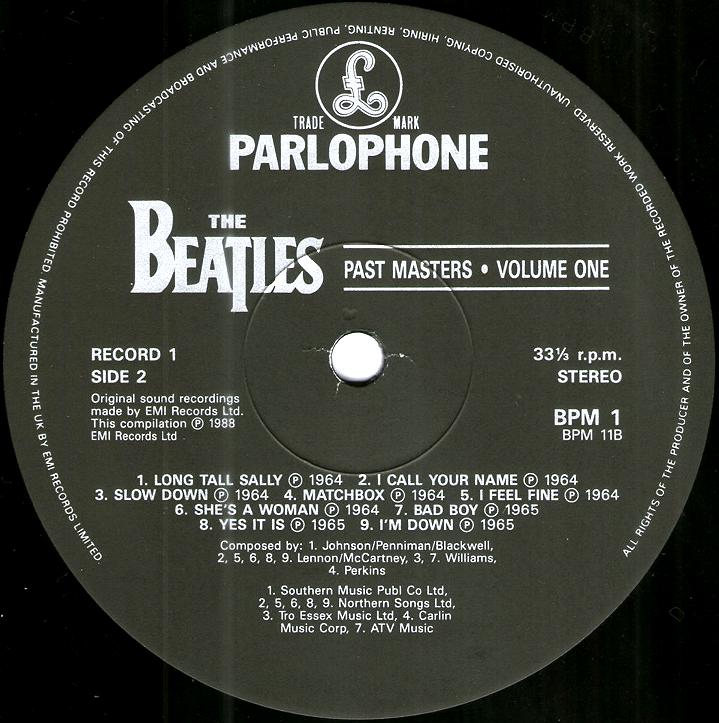
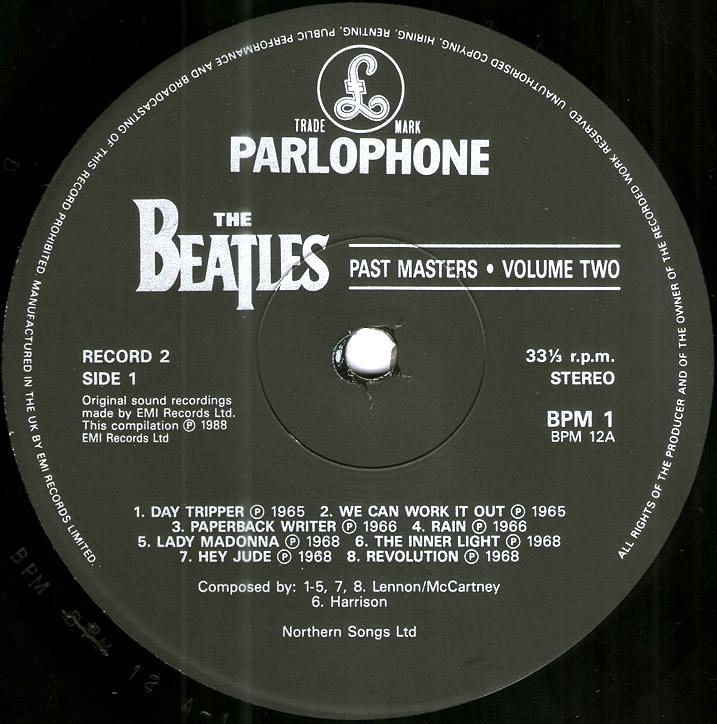
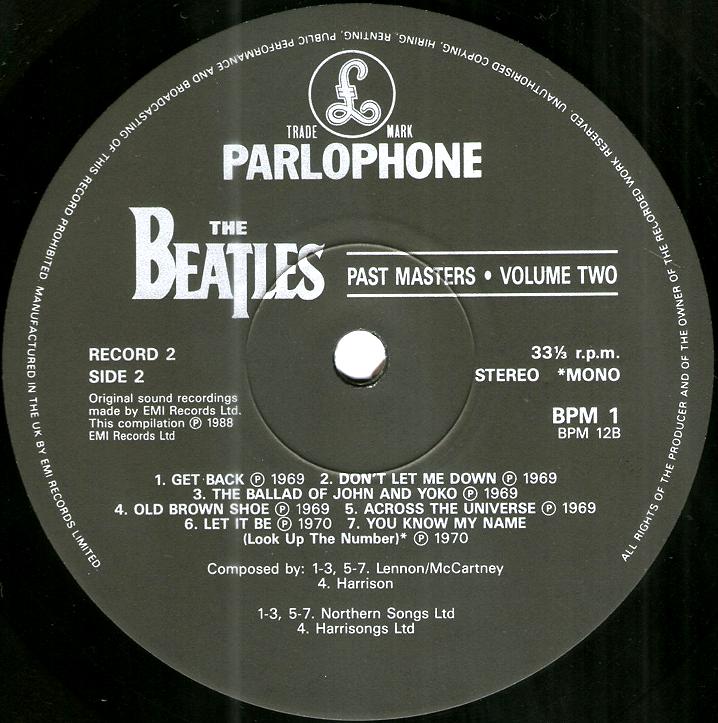
3. Third pressing, early 2000s. The gatefold outer sleeves have the Apple logo on the back side. Records are housed in white plain paper inner sleeves. This edition is characterized by wide grooves which are clearly visible on the labels. Black label with dark silver Parlophone logo and dark silver print. “ALL RIGHTS OF THE PRODUCER” printed at the start perimeter print. Importantly, around the 11 o’clock position in the rimtext the wording is (right to left): “UNAUTHORISED COPYING, HIRING, RENTING, PUBLIC PERFORMANCE AND BROADCASTING”. “MANUFACTURED IN THE UK BY EMI RECORDS” text at the end of the perimeter print. Matrix number variations: Record One – Side 1: BPM 11 A-02-01-1; Side 2 BPMBTM 12 A-1-1-2; Side 2 BPM
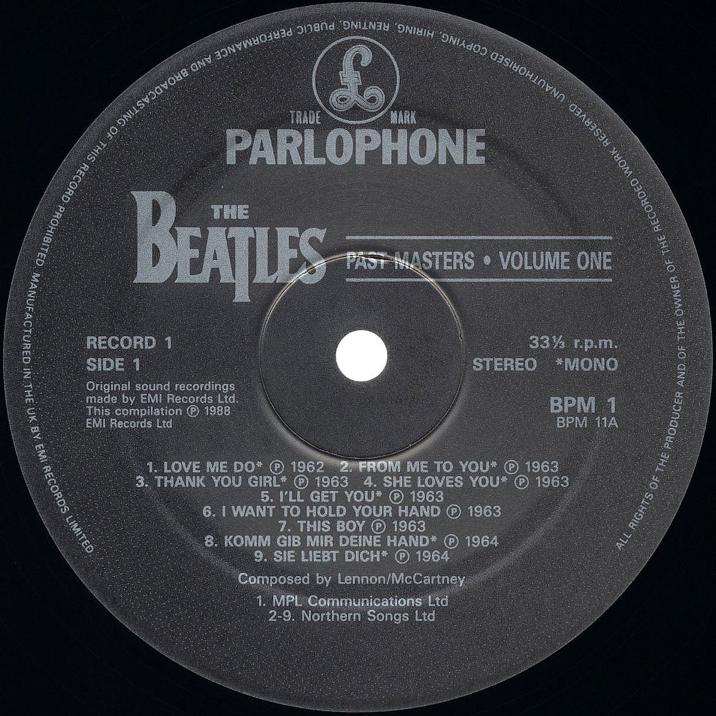
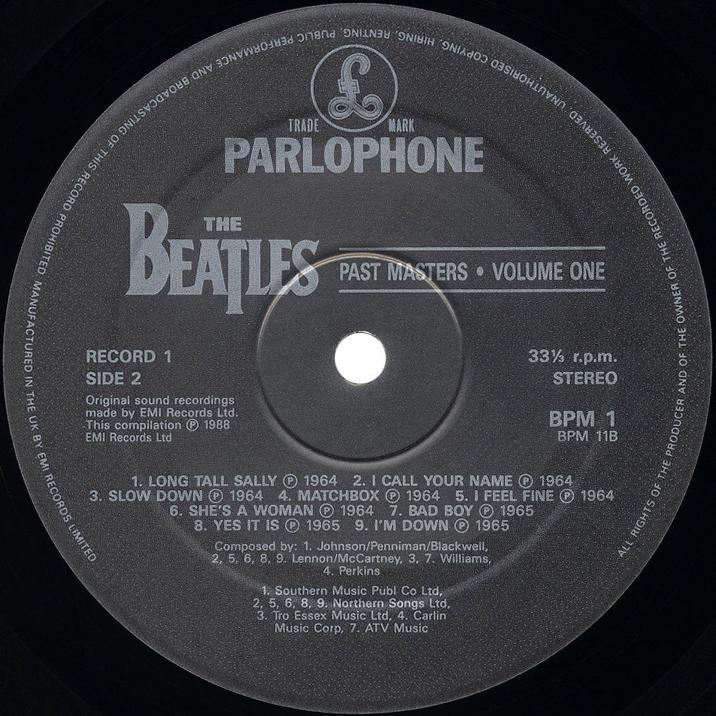
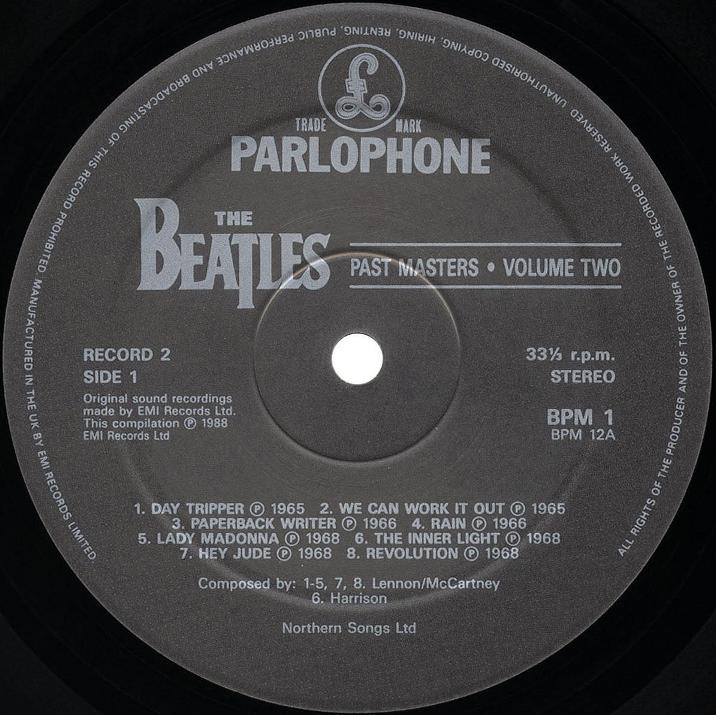
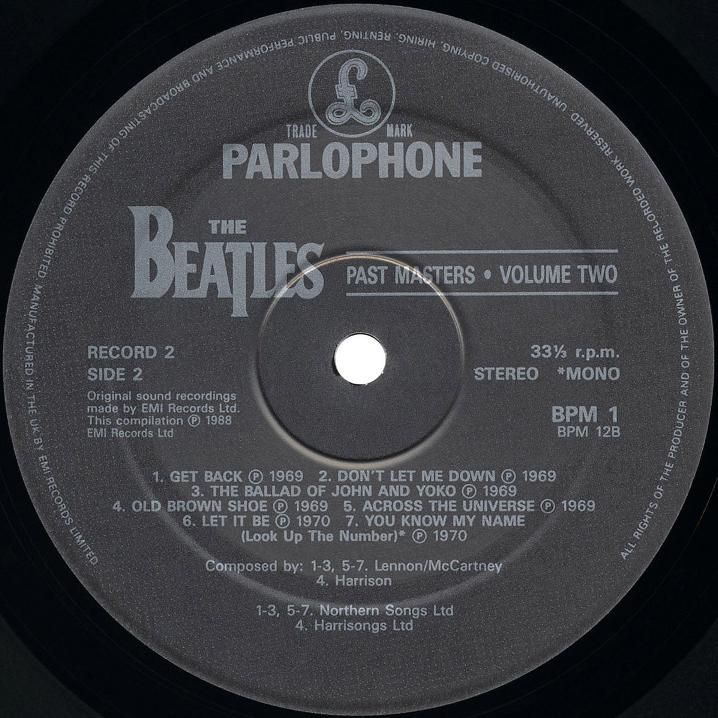
The “Gold and Black” label design appeared on Parlophone LP labels from at least as far back as 1957 and bears a resemblance to the older 78 rpm labels. It was discontinued around May, 1963 at the latest. Black label with gold print with side numbers printed as: 1 and 2 used between autumn 1960 and April 1963. Before the spring of 1963, the stereo label had the same “Gold & Black” design as the mono label, although with stereo banner printed below the Parlophone logo.
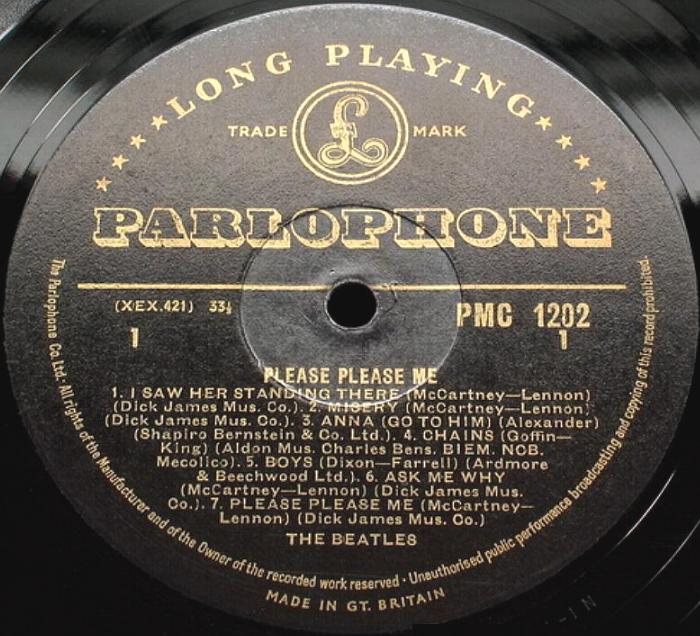
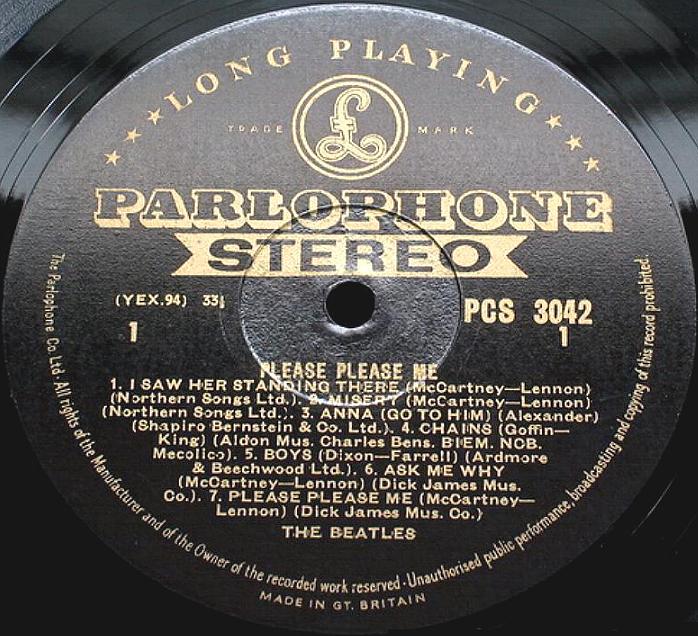
When ‘Please Please Me’ was originally released Parlophone were in the process of updating the style of their record labels to appear more modern. The 7″ labels had been changed from red to black in January of 1963 and by May the LP’s gold and black scheme was changing to yellow and black. The ‘Yellow and Black’ label design which would remain throughout the 1960s. Almost immediately after the labels were changed from the Gold design to the Yellow, it was soon discovered that although the new labels featured the ’33 1/3′ prefix prominently above the Parlophone name, part of the label print plates were left unchanged whilst the transition was taking place. Because of this, the small ’33 1/3′ prefix that appeared to the right of the matrix number on the gold label remained. Since there was no need for the prefix to be included twice the smaller one was removed pretty much instantaneously after it’s discovery. This first black and yellow label without publishing year used a very short time: summer 1963 only. After April 1963 the stereo looked like the mono labels, except for the record number prefix and the word “STEREO” printed on the right side above the Parlophone logo. The stereo label changed follow the label changed for the mono LPs.
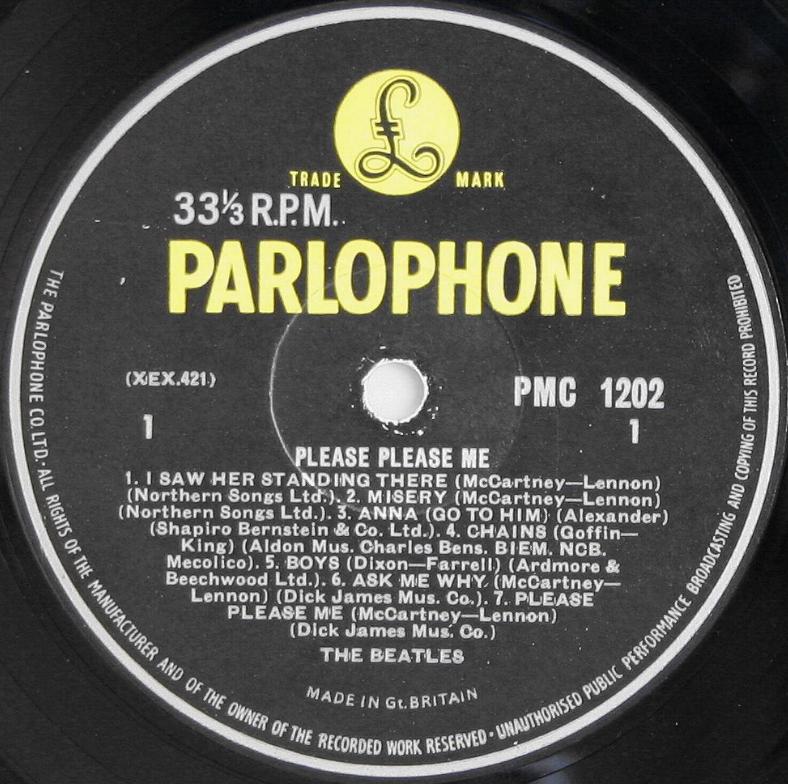
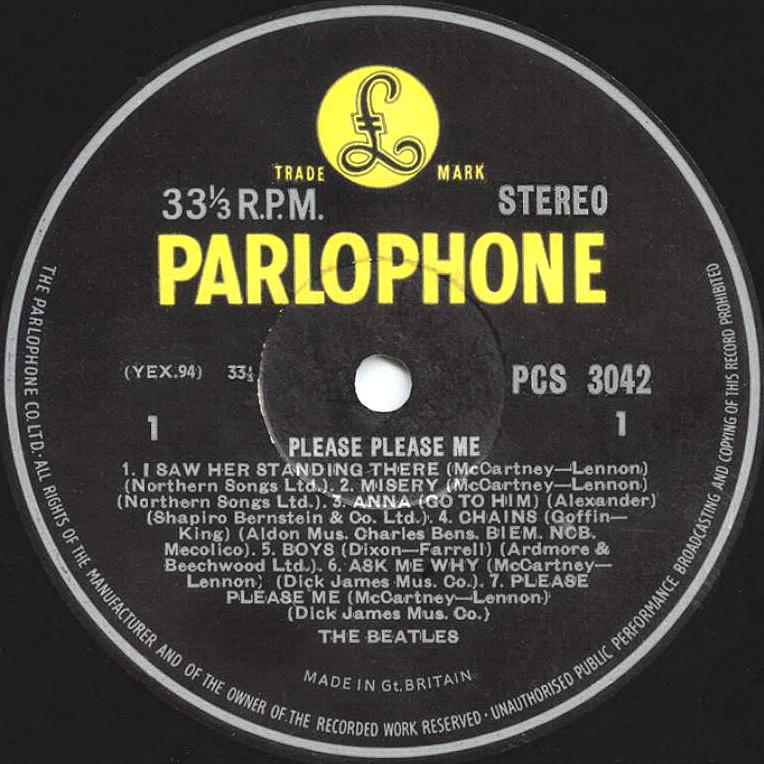
Parlophone started with a new re-designed label in 1963. It was black with a yellow logo and silver print. The publishing year was now printed on the label, as “RECORDING FIRST PUBLISHED 1963”. The beginning of the perimeter print was written with a fully capitalized “THE PARLOPHONE CO LTD…”. This label used between summer 1963 and January 1964.
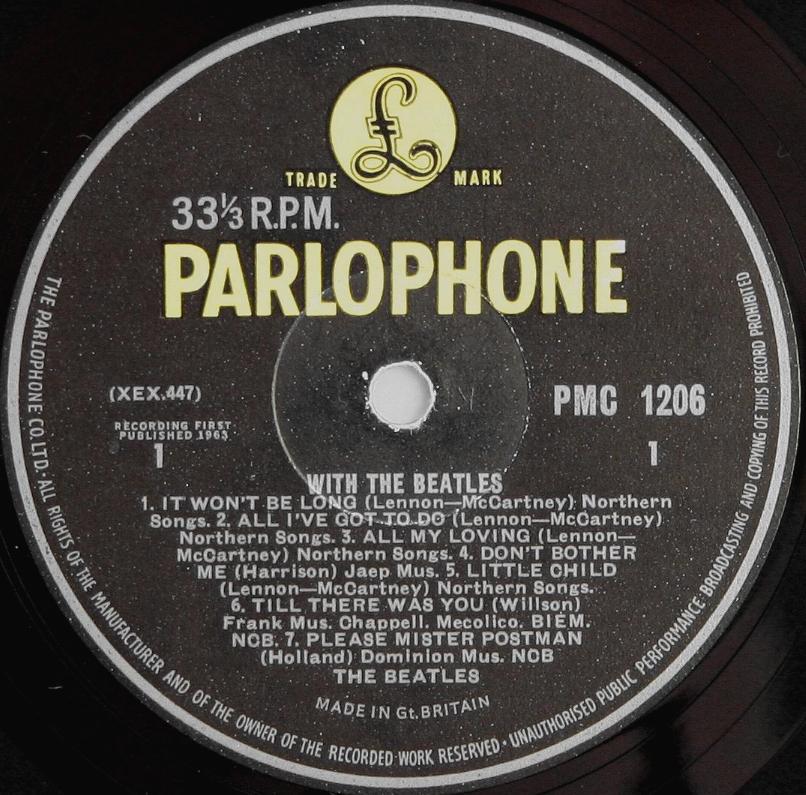
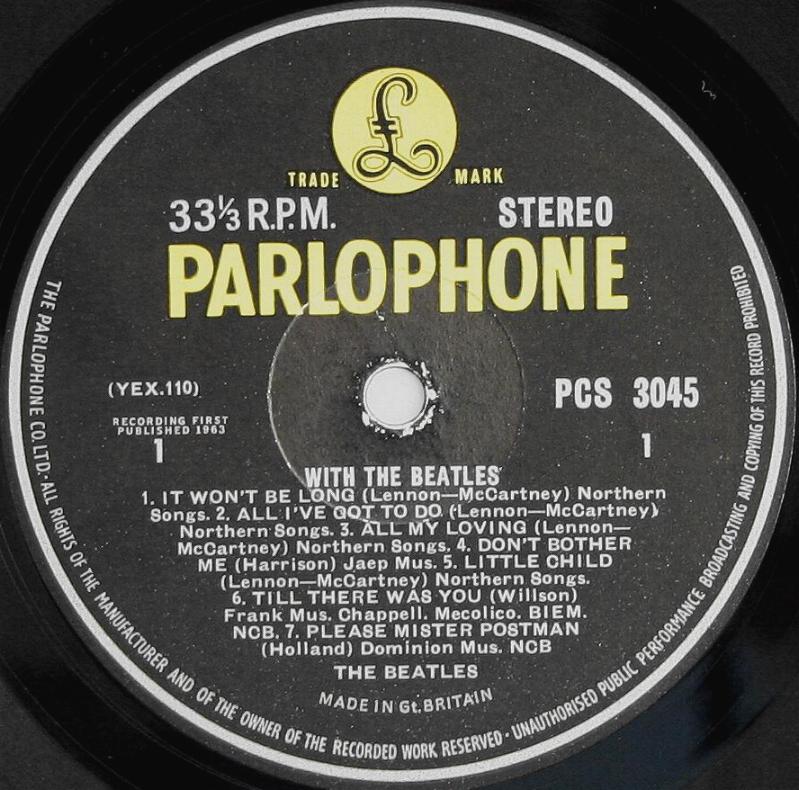
The text “SOLD IN U.K. SUBJECT TO RESALE PRICE CONDITIONS, SEE PRICE LISTS” was printed on EMI records between February 1964 and June 1969. This wording was supposed to be on UK releases only, but it also appears frequently on exported records. Black label with yellow logo and silver print with “RECORDING FIRST PUBLISHED…”, “THE PARLOPHONE” printed at the start of the perimeter print and with “SOLD IN U.K…” used between Fabruary 1964 and Jenuary 1965.
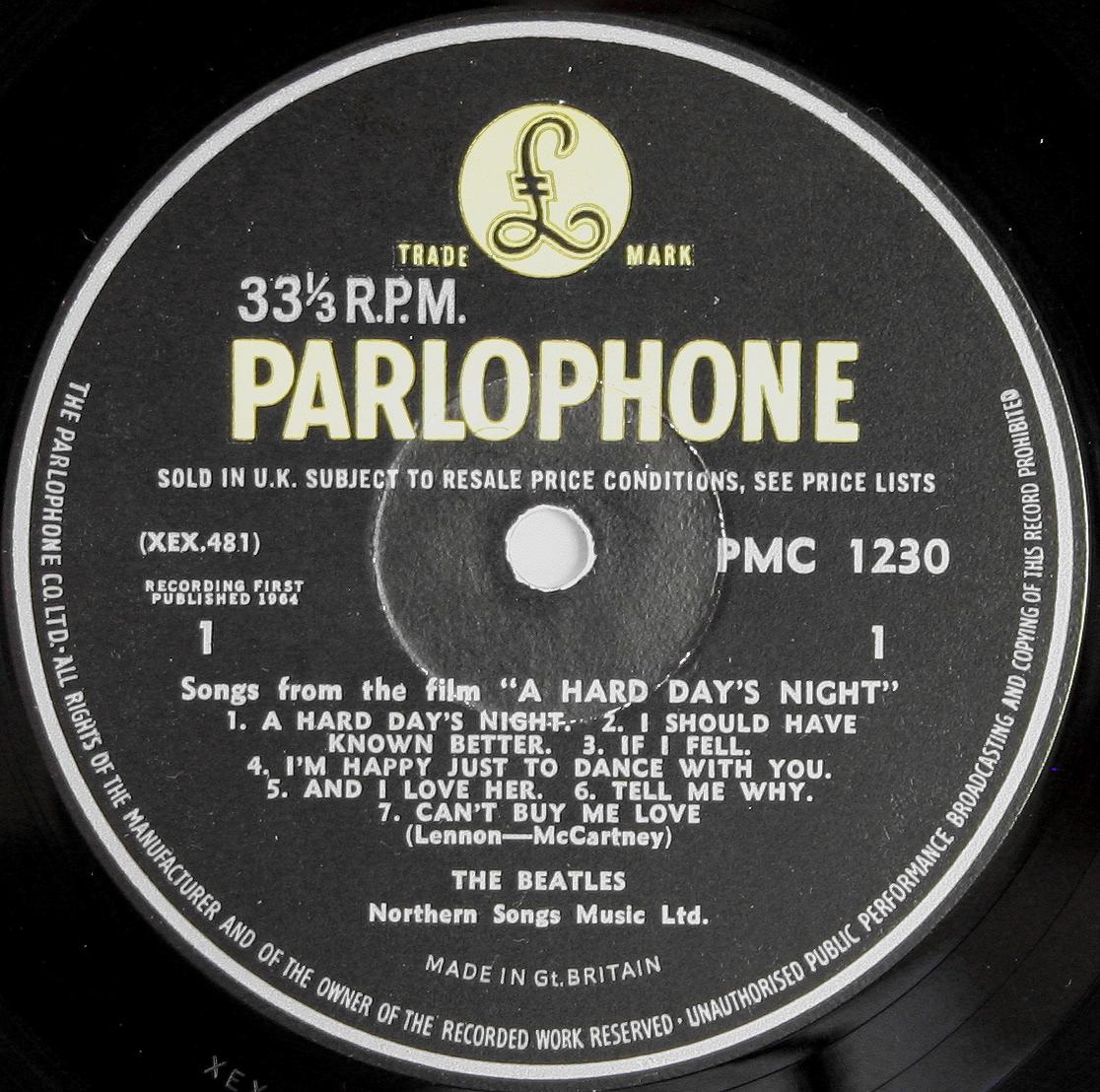

Parlophone started to print the publishing year as “(p) 1965” in early 1965. Label has “THE PARLOPHONE” printed at the start of the perimeter print and “SOLD IN U.K….” text. This label was in use for a relatively short period of time before the perimeter print was changed. The text “RECORDING FIRST PUBLISHED“ was removed from the label. It was originally believed that the “RECORDING FIRST PUBLISHED” text and “THE PARLOPHONE” rimtext were changed at the same time, but recently a very small number of stereo Beatles albums have emerged that show there was a slight delay between the introduction of the two. No mono copies with this feature have surfaced to date. Label used between January 1965 and summer1965.
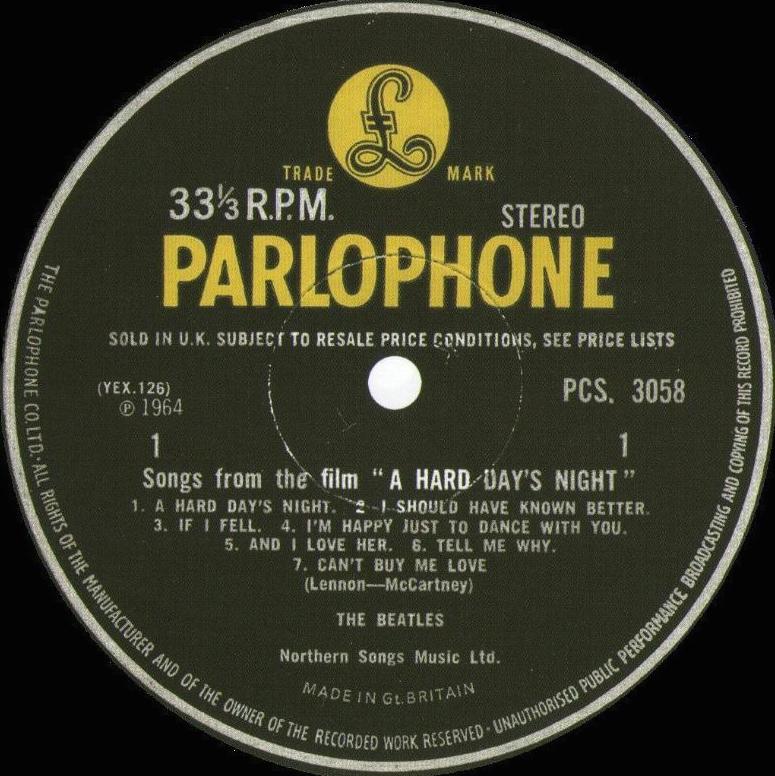
The start of the perimeter print was changed to “THE GRAMOPHONE CO LTD…” in summer of 1965. Label has “THE GRAMOPHONE” printed at the start of the perimeter print, “SOLD IN U.K….” text and publishing year printed as: (p) 1966. This label used between summer 1965 and summer 1969.
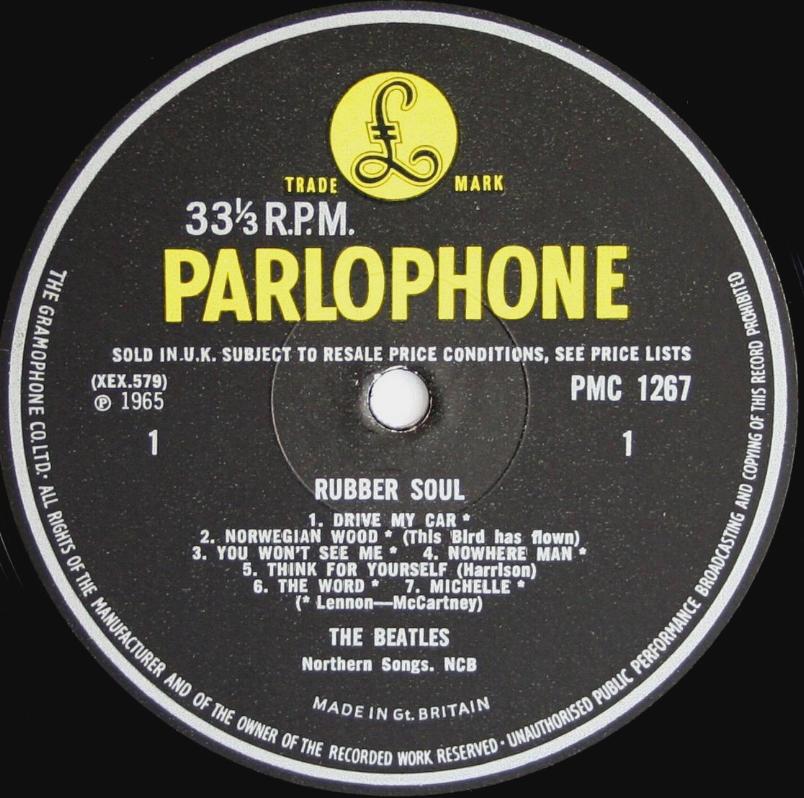
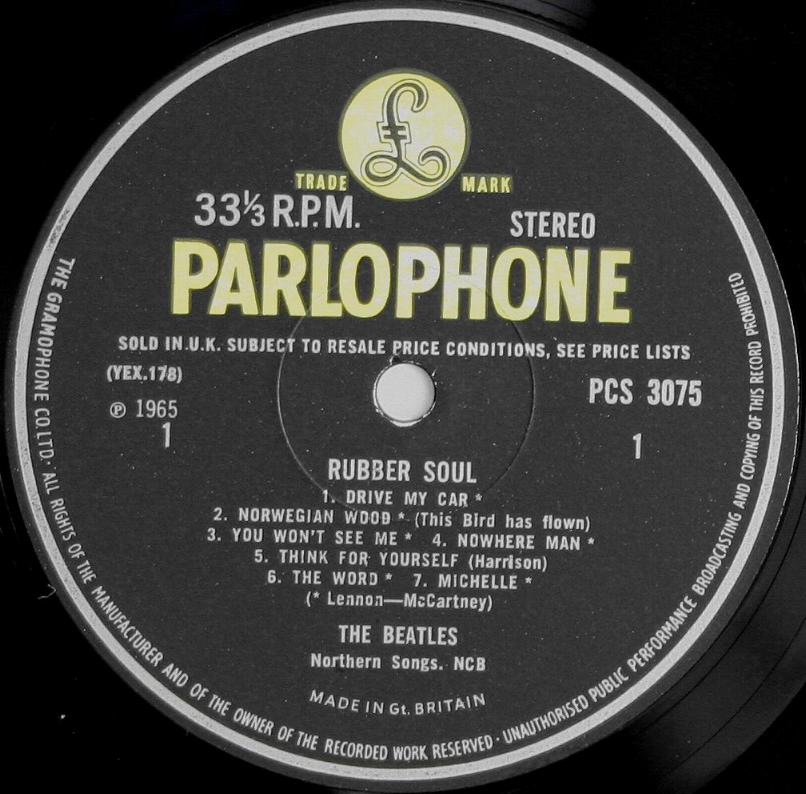
Parlophone ceased to use different record numbers for stereo and mono releases in the early spring of 1966 and restarted the record number series at 7001.
The text “SOLD IN U.K. SUBJECT TO RESALE…” was removed from the label in summer 1969. Parlophone continued to use the “Black & Yellow” labels until November 1969. Label without “SOLD IN U.K. SUBJECT TO RESALE…” used between summer 1969 and November 1969.
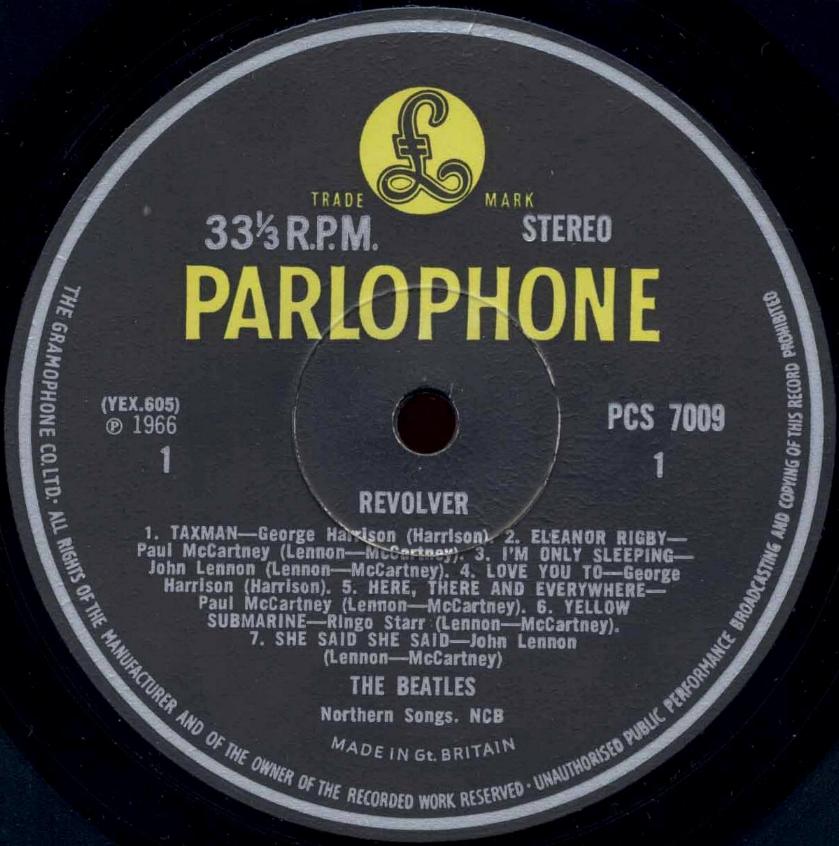
Parlophone started to use a newly disigned label in late 1969. Parlophone radically changed their label design to this silver style with an EMI boxed logo at the bottom of the label, and the rim text now arches around the top of the label rather than underneath. This new label collectors refer to as the “Silver and Black” design. The original label printer plates were used although the stereo mark was moved from the top to just above the catalogue number. It was thought many years ago that Parlophone had closed their mono back catalogue before the label design changed and as such no mono copies existed on this label, but over the years it transpired that three albums from the Beatles back catalogue had their mono runs reissued. These three albums were “Please Please Me”, “Help!” and “Sgt. Peppers Lonely Hearts Club Band”. These mono presses are incredibly rare and very difficult to get your hands on. Label used between 1969 and early 1971.

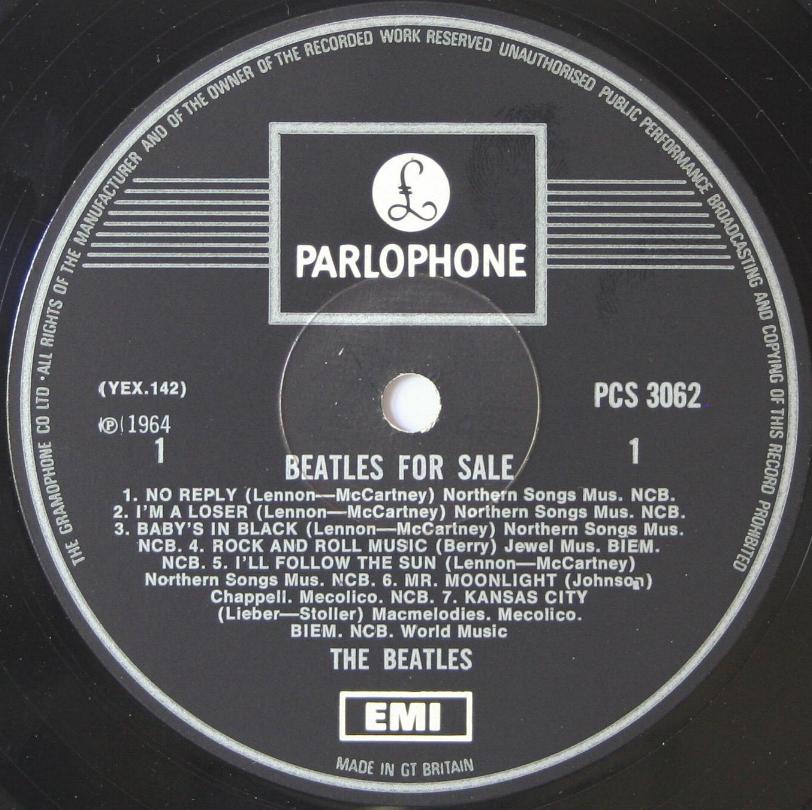
Parlophone added another EMI logo at the top of the label in 1971. White EMI logo on a black background was changed to black EMI logo on a white background. This label used between early 1971 and 1973.

Parlophone temporarily ceased to release LPs in 1973 because of the oil crisis began. LPs production was moved to France for some time.
Parlophone resumed production LPs in 1976. The start of the perimeter print was changed to “EMI RECORDS LTD…”. The tex “GT. BRITAIN” was removed from the label. Instead, added “MADE IN GT. BRITAIN” text at the end of the perimeter print. This label used between summer 1976 and october 1980. To do this, EMI make new laqueurs at Abbey Road Studios. All albums were cut by Harry T. Moss. Therefore, the trail off area has its initials HTM. EMI reissued 13 Beatles stereo albums as a box set (Parlophone BC 13, in blue box) December 15, 1978.
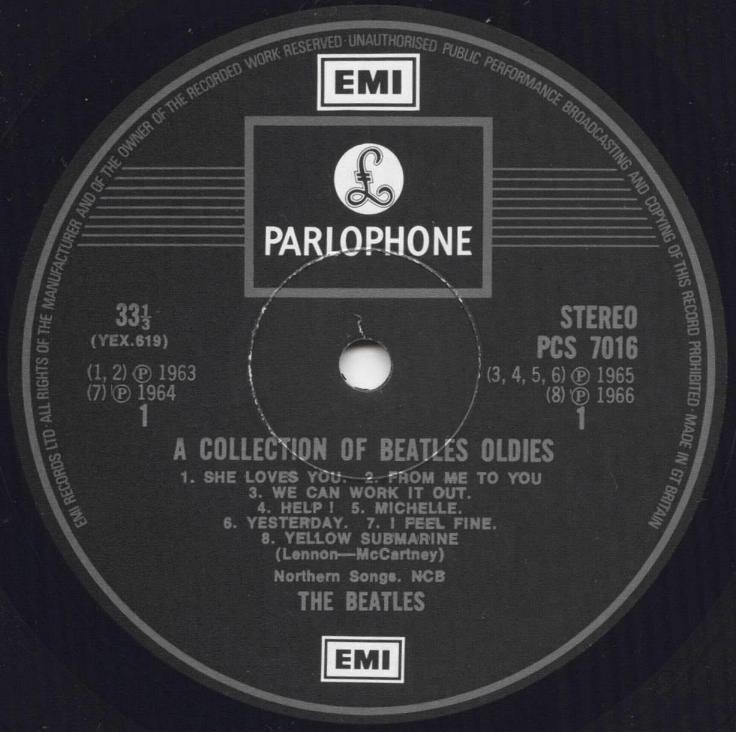
In October 1980 the rimtext was again slightly altered so that it started with “ALL RIGHTS OF THE PRODUCER…”. Importantly, around the 11 o’clock position in the rimtext the wording is: “…UNAUTHORISED PUBLIC PERFORMANCE, BROADCASTING, COPYING AND HIRING…”. Instead, added “MANUFACTURED IN THE UK BY EMI RECORDS LIMITED” text at the end of the perimeter print. This label used between October 1980 and April 1984.

In summer 1981, EMI returned briefly in the 60’s design. Reappears yellow Parlophone logo on a black background. These Parlophone labels has around the 7 o’clock position in the rimtext the wording is: “…UNAUTHORISED PUBLIC PERFORMANCE, BROADCASTING, COPYING AND HIRING…”. EMI reissued the original 10 Beatles mono albums (8 albums on the Parlophone and 2 albums on the Apple) individually in July 1981, using, in most cases, original 1960s tube cuts. The LPs were distributed to department stores and record shops with a street date of 27 July 1981 (except Beatles For Sale and Yellow Submarine which were not available until a few weeks later) and were all sold by the end of 1981. In August 1982 EMI UK reissued these 10 Beatles mono albums as a box set (Parlophone BMC 10, in black box and in red box). And by then many of the LPs had received new solid state recuts by Harry T Moss.

EMI starts to make use of digital recording technology in 1981. This changes the matrix numbers on a longer (YEX 110-6-1-1-1) and removed stamper numbers. Later appear letter D (Digital) in the matrix numbers (for example YEX 179-6-1-3 D). The first time, digital technology is used in parallel with standard analog. So, sometimes on the one record, you can see the matrix numbers for the two different types.
At the end of spring 1984, the rimtext was again slightly altered. Importantly, around the 11 o’clock position in the rimtext the wording is: “UNAUTHORISED COPYING, HIRING, RENTING, PUBLIC PERFORMANCE AND BROADCASTING…”. This label used between April 1984 and 1987.
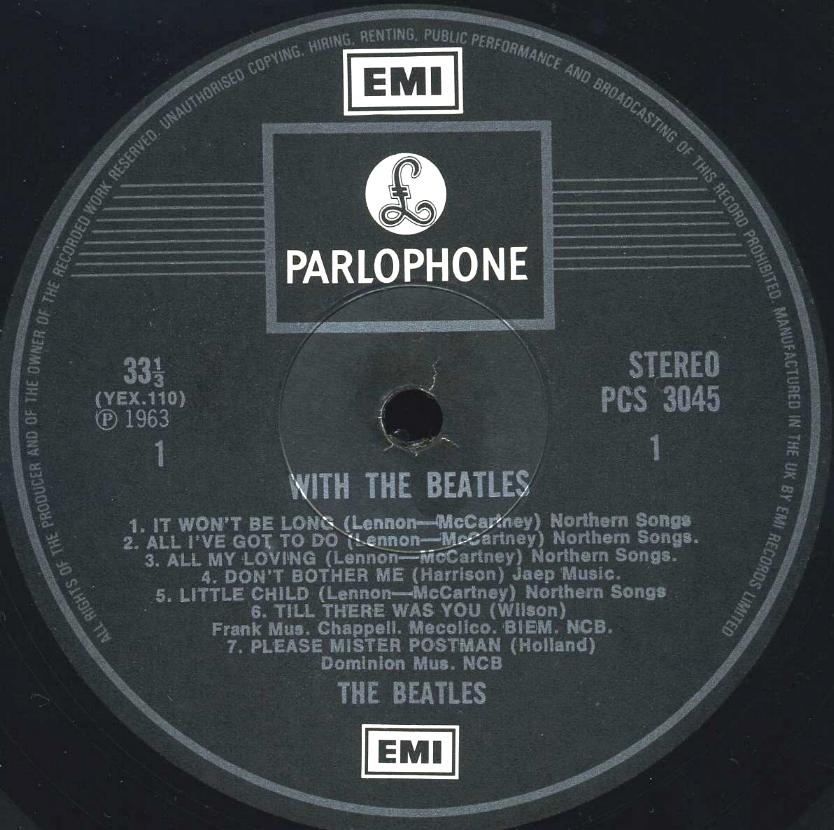
EMI reissued original Beatles albums in 1987, using DMM (Direct Metal Mastering) technology. First four albums were reissued in mono (“Please Please Me”, “With The Beatles”, “A Hard Day’s Night” and “Beatles For Sale”), other albums were reissued in stereo. Color EMI logos is changed to silver. The rimtext was again altered. Importantly, around the 11 o’clock position in the rimtext the wording is: “UNAUTHORISED COPYING, PUBLIC PERFORMANCE, BROADCASTING, HIRING AND RENTAL…”. Instead, added “MADE IN ENGLAND” text at the end of the perimeter print. This label used between 1987 and 1991.

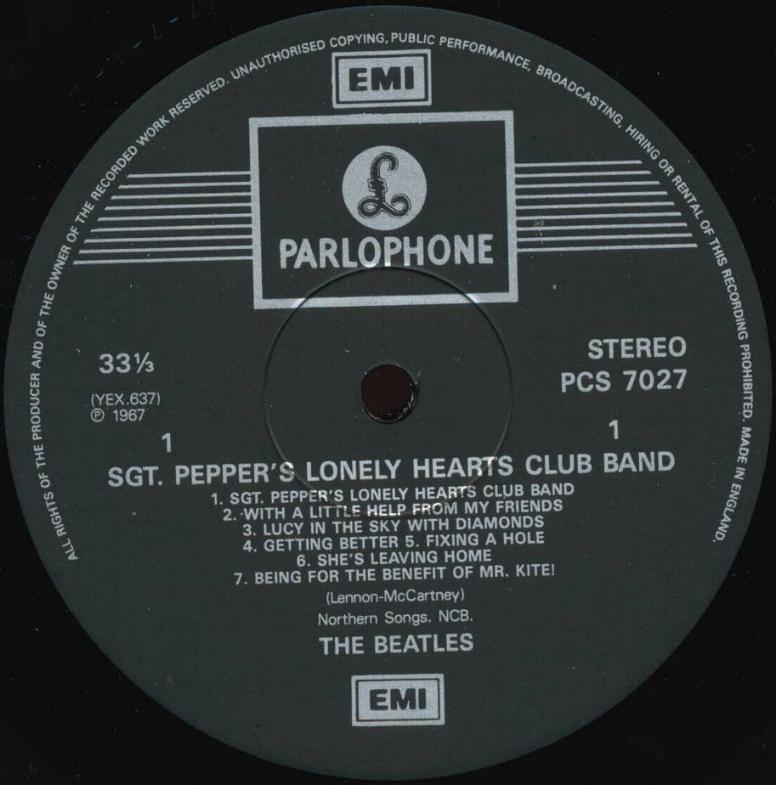
Records with identical label design was reissued in 2003. This vinyl was manufactured by Haarlem, Holland. These records were made by order of EMI and intended for export to England. The only difference is a dish effect underneath the labels impressed into the vinyl itself. Therefore, labels have identical “Made In England” text at the end of the perimeter print. Addition, some labels contain the number below the name. This number is identical to the barcode on the sleeve. But this is not English edition. In this edition there are many misprints and mispressings.

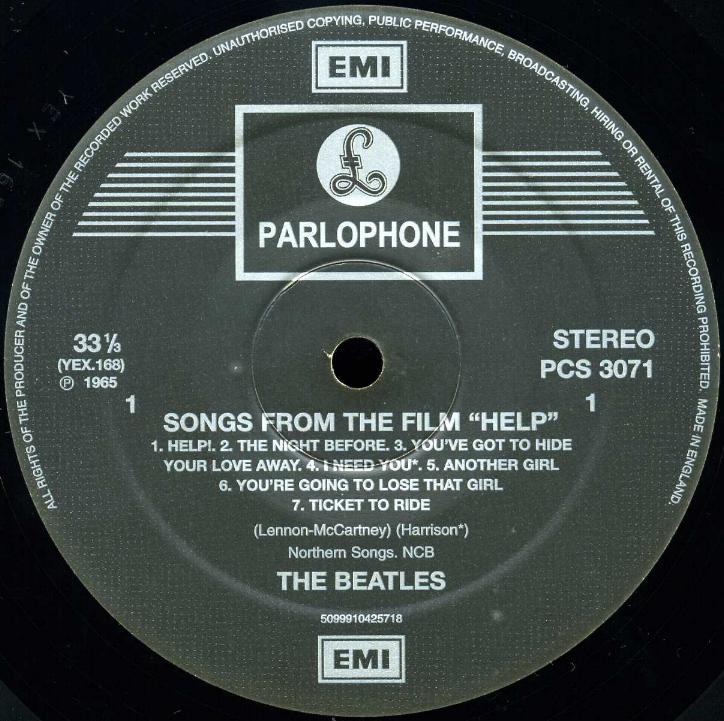
Parlophone started to use a newly disigned label in 1988. Parlophone radically changed their label design to silver print on a black background and removed EMI boxed logos. These labels have a silver Parlophone logo at the top. March 7, 1988, EMI issued new Beatles album “The Beatles Past Masters” with this new label design. This is the last Beatles album issued Parlofone Records on vinyl. The same design was used to re-release of “20 Greatest Hits”.

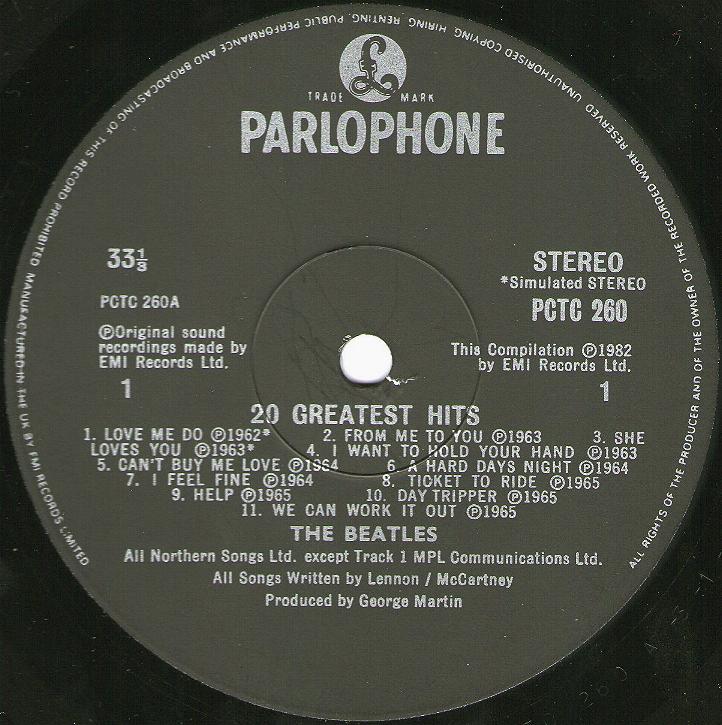
Release 1965. This English version of “The Beatles’ Second Album” has the same track list as the American version. But the stereo track of the “Thank You Girl” officially published in England on the album “Past Masters Vol. 1″, in 1988.
Garrod & Lofthouse Ltd. front laminated flipback sleeve, small “stereo” on front.

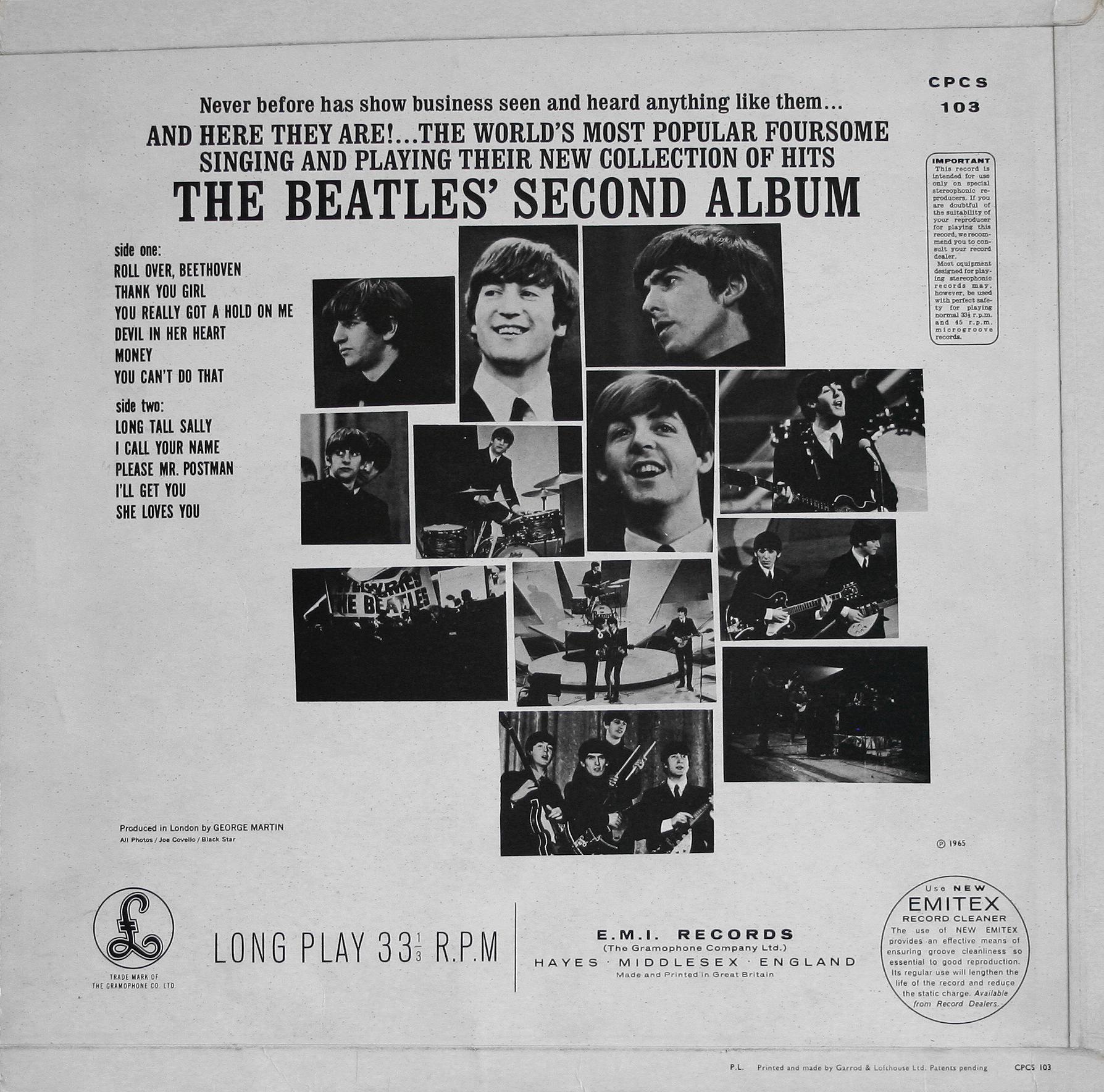
1. First pressing, 1965. Black & Yellow Parlophone label with “The Gramophone Co. Ltd” perimeter print. Tracing-paper-lined “Use Emitex“ die-cut inner sleeve. Matrix numbers: Side 1: YEEX 110-A9; Side 2: YEEX 111-A9.
Variation 1. Misspelled credit as “McCarthy-Lennon” after “Thank You Girl” on the side 1.


Variation 2. With correct credit as “McCartney-Lennon” after “Thank You Girl” on the side 1.
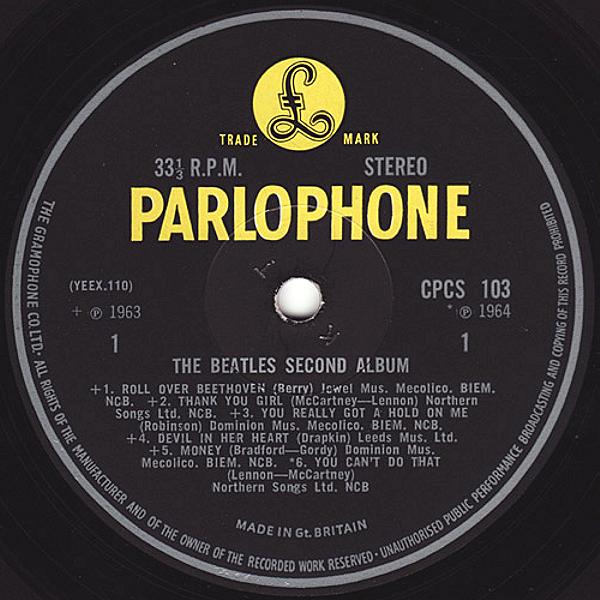
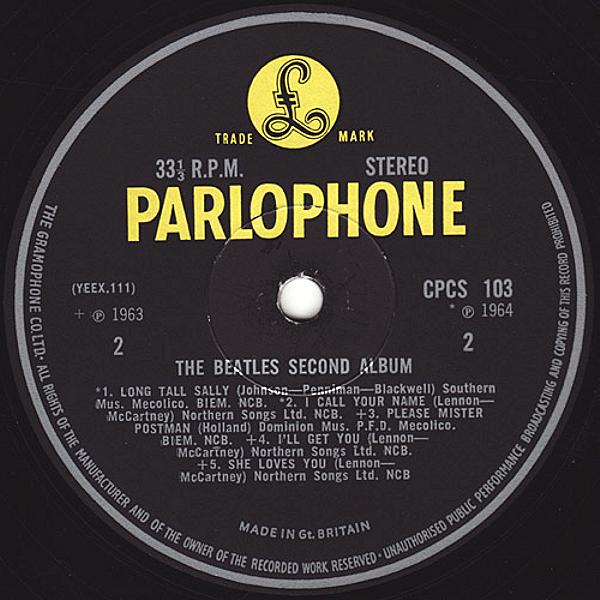
2. Second pressing, November 1969 until 1970. Black label with one silver EMI logo and silver print. “The Gramophone Co Ltd” printed at the start perimeter print and “Made In GT. Britain” lower text. Sepia, black & white LP advertising or white paper “Patent…” inner sleeves. Matrix numbers: Side 1: YEEX 110-A9; Side 2: YEEX 111-A9.
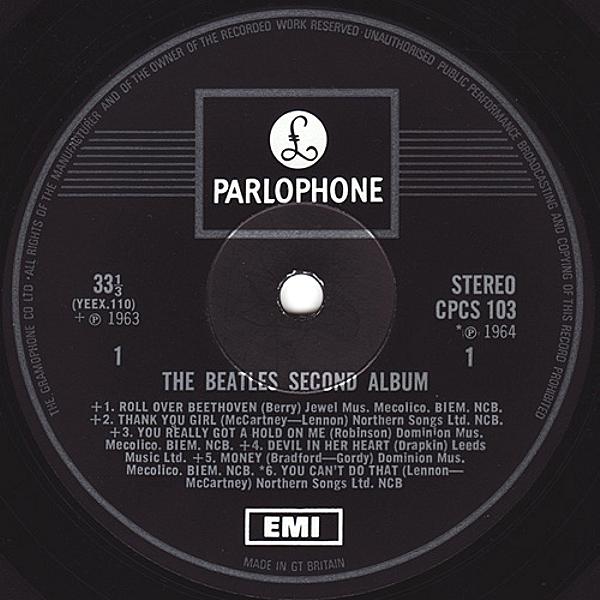
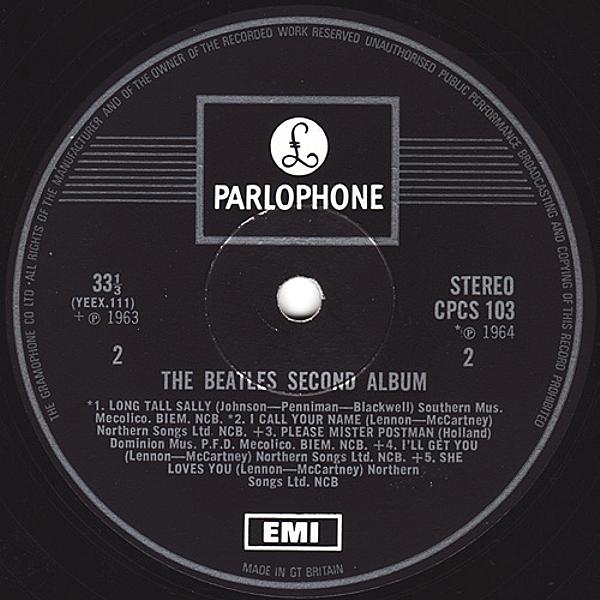
3. Third pressing, late 1970 – early 1971. Black label with two silver EMI logos and silver print. “The Gramophone Co Ltd” printed at the start perimeter print and “MADE IN GT. BRITAIN” lower text. White paper “Patent…” inner sleeves. Matrix numbers: Side 1: YEEX 110-A9; Side 2: YEEX 111-A9.
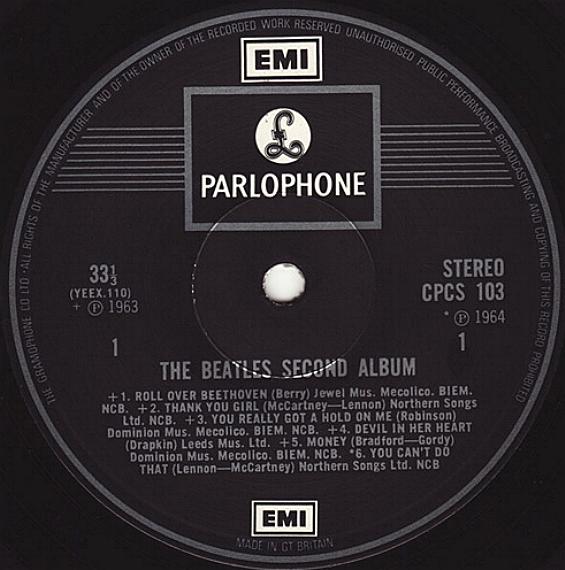

First pressing, released November 13, 2000. Surprising though it may seem, when “1” was released it was the first single-album compilation of Beatles hits since “20 Greatest Hits” 18 years earlier. The idea was simple, a collection of all The Beatles’ No.1 hits in the UK and US. Although the majority of their singles topped the charts in both countries, the first and last tracks on the compilation illustrated how this was not always the case. The songs on 1 were remastered specifically for the release in 2000. The remastering was overseen by Peter Mew of Abbey Road Studios and took place there.
The first pressing has a gatefold sleeve with Apple logo on back side and date 2000, and with credits: “Beatles”, “Apple” and the Apple logos are trademarks of Apple Corps. Ltd”.
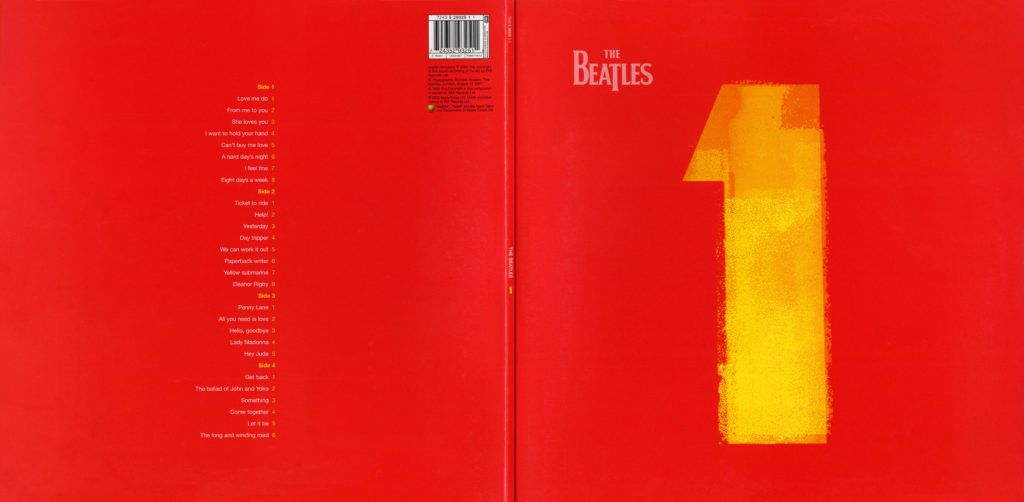
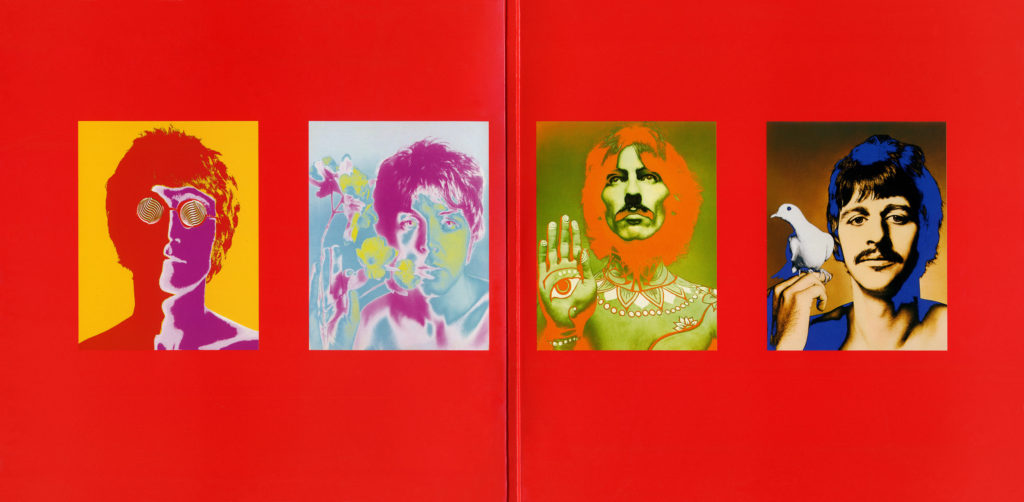
The album included the four celebrated portraits of the group by photographer Richard Avedon…
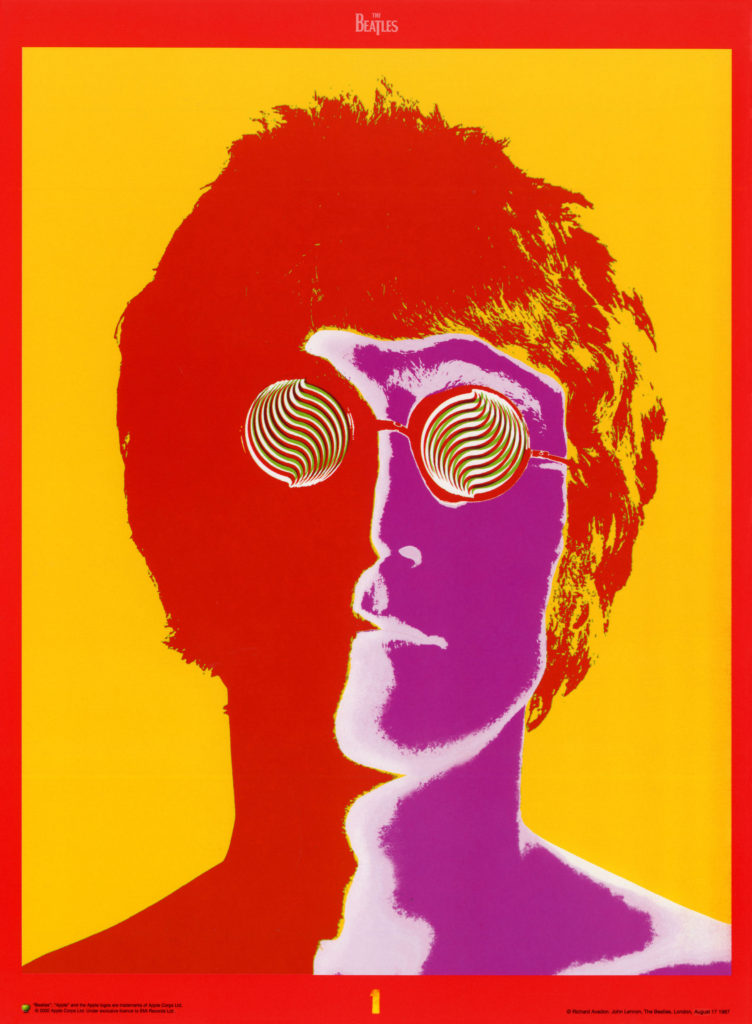
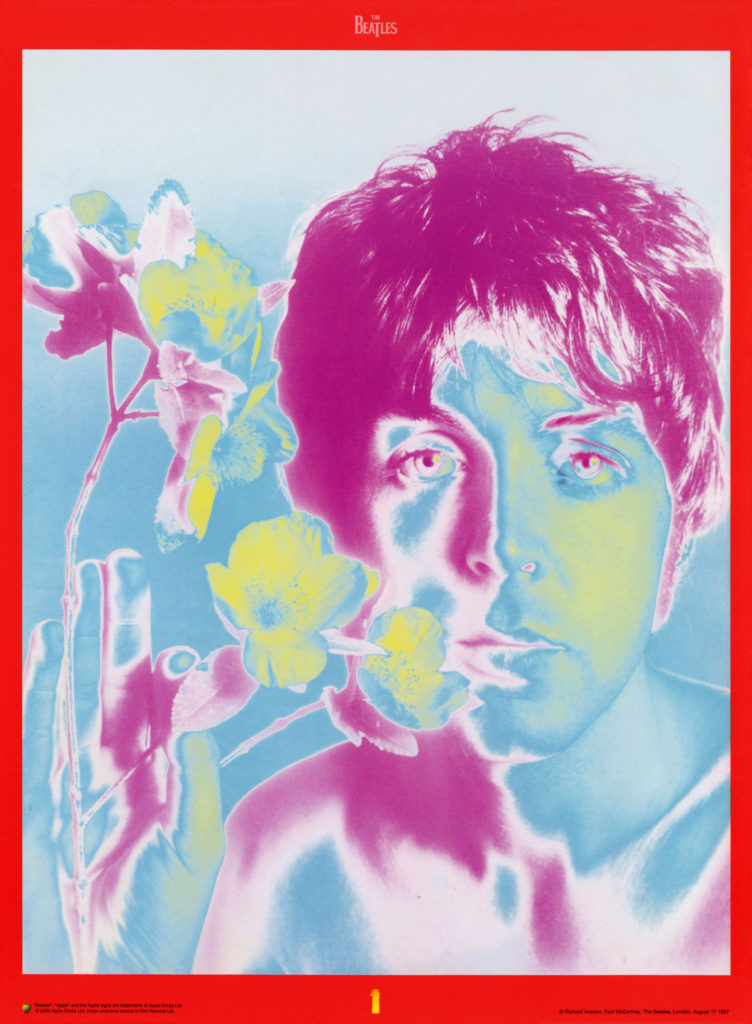
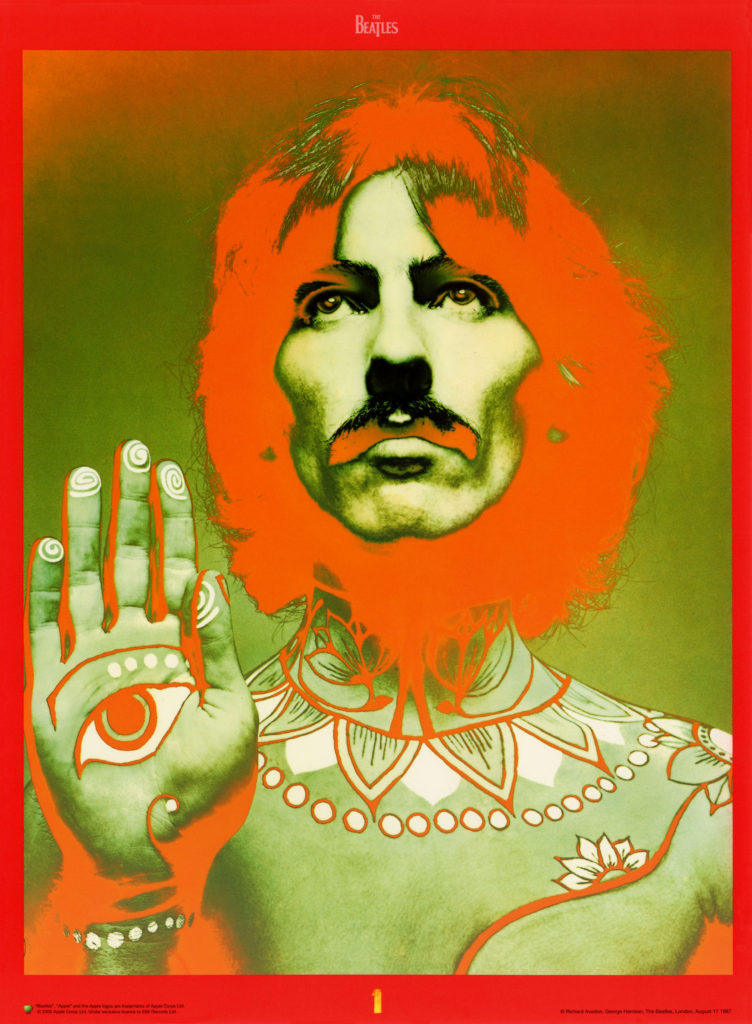
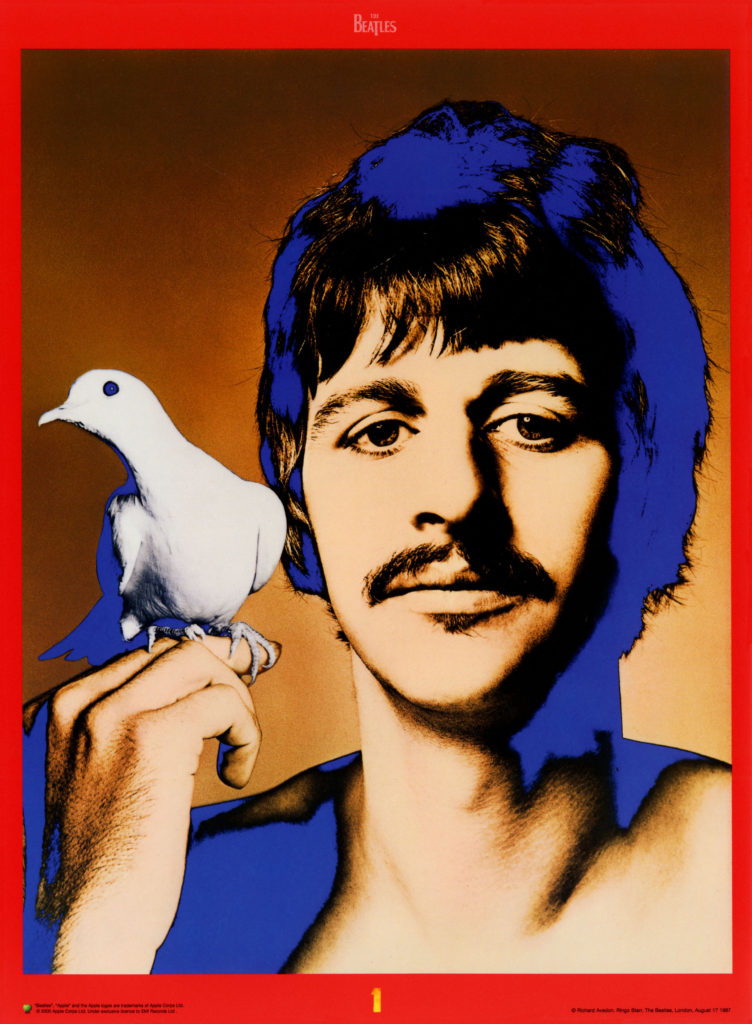
…and a 24″ by 36″ poster of 126 different singles picture sleeves.
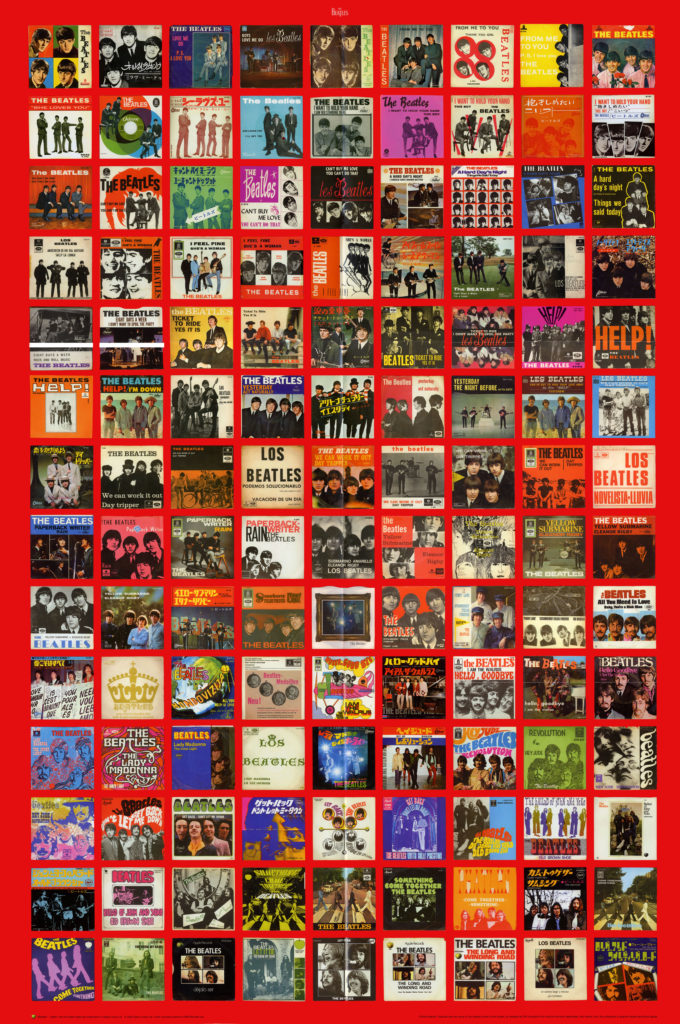
Records was housed in a original pictures inner sleeves with cut-out on the back sides.
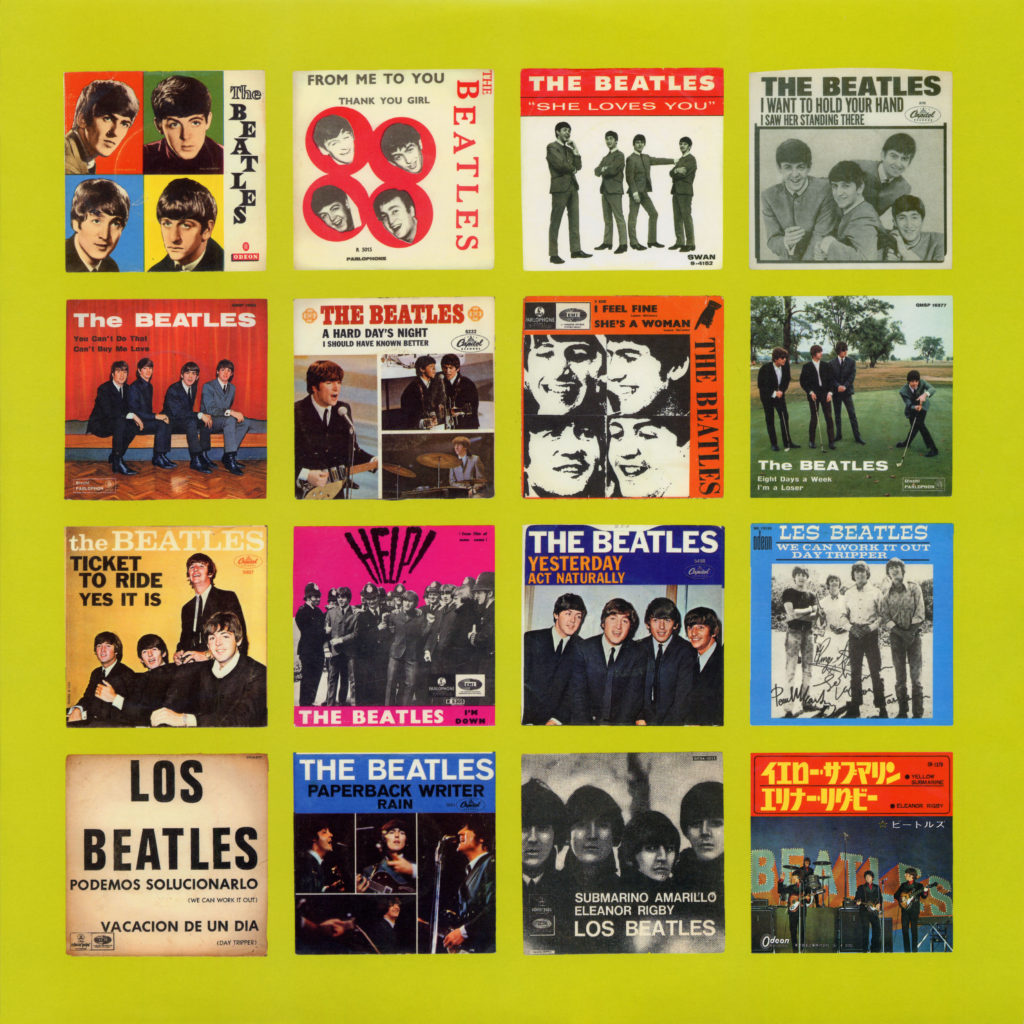
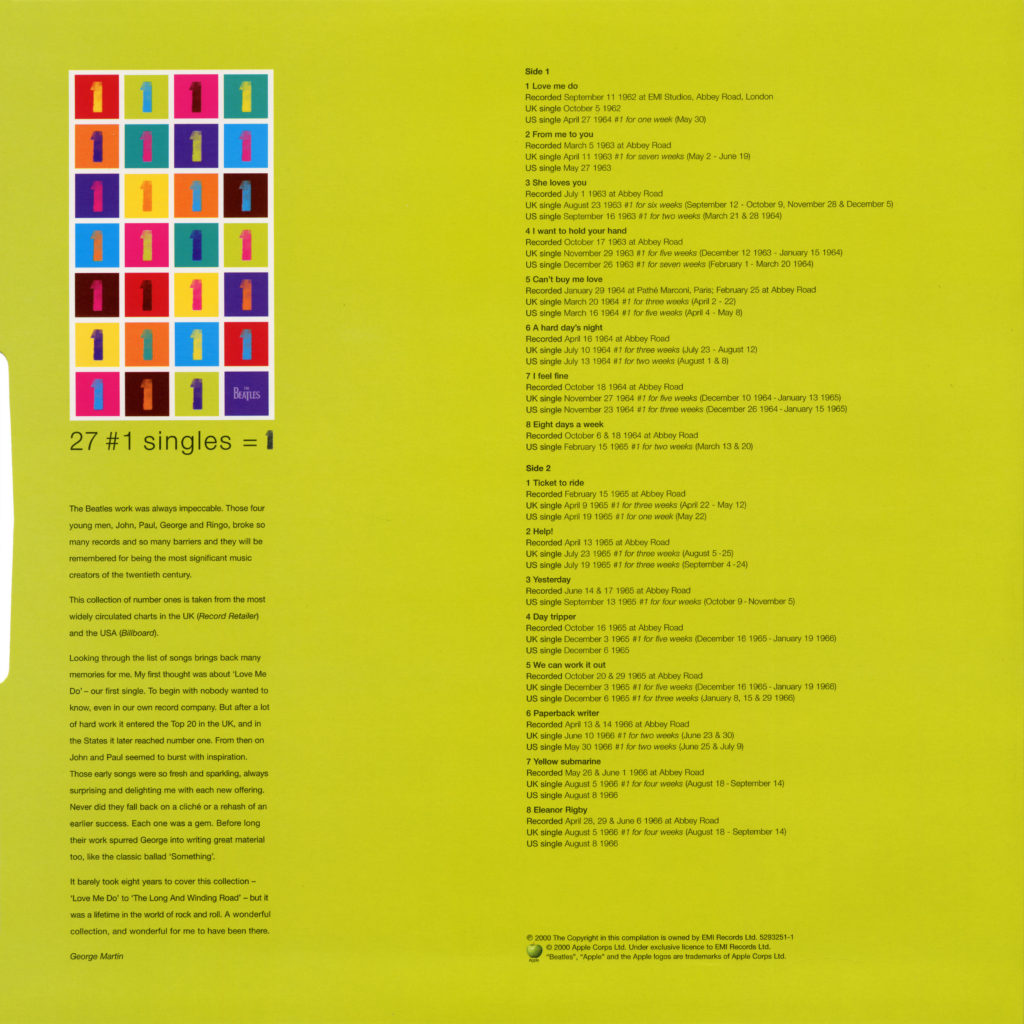
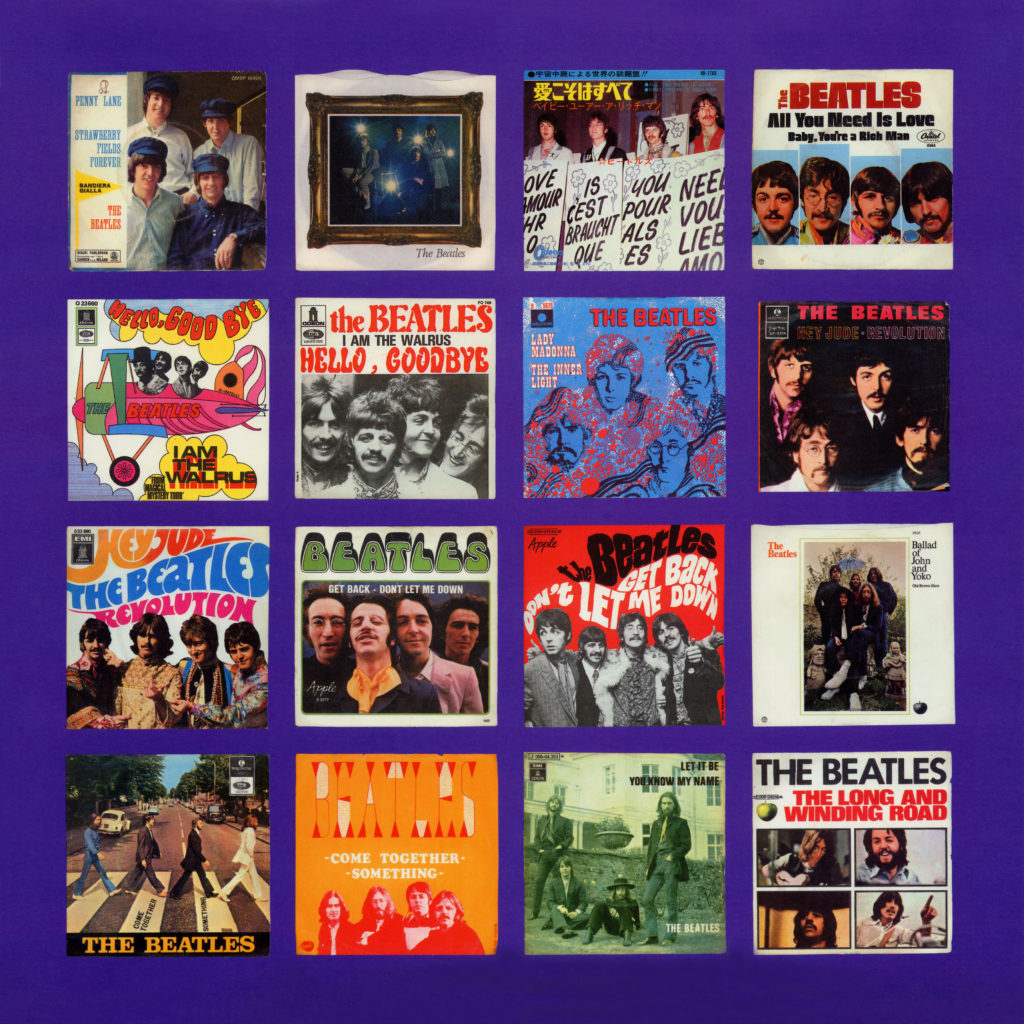
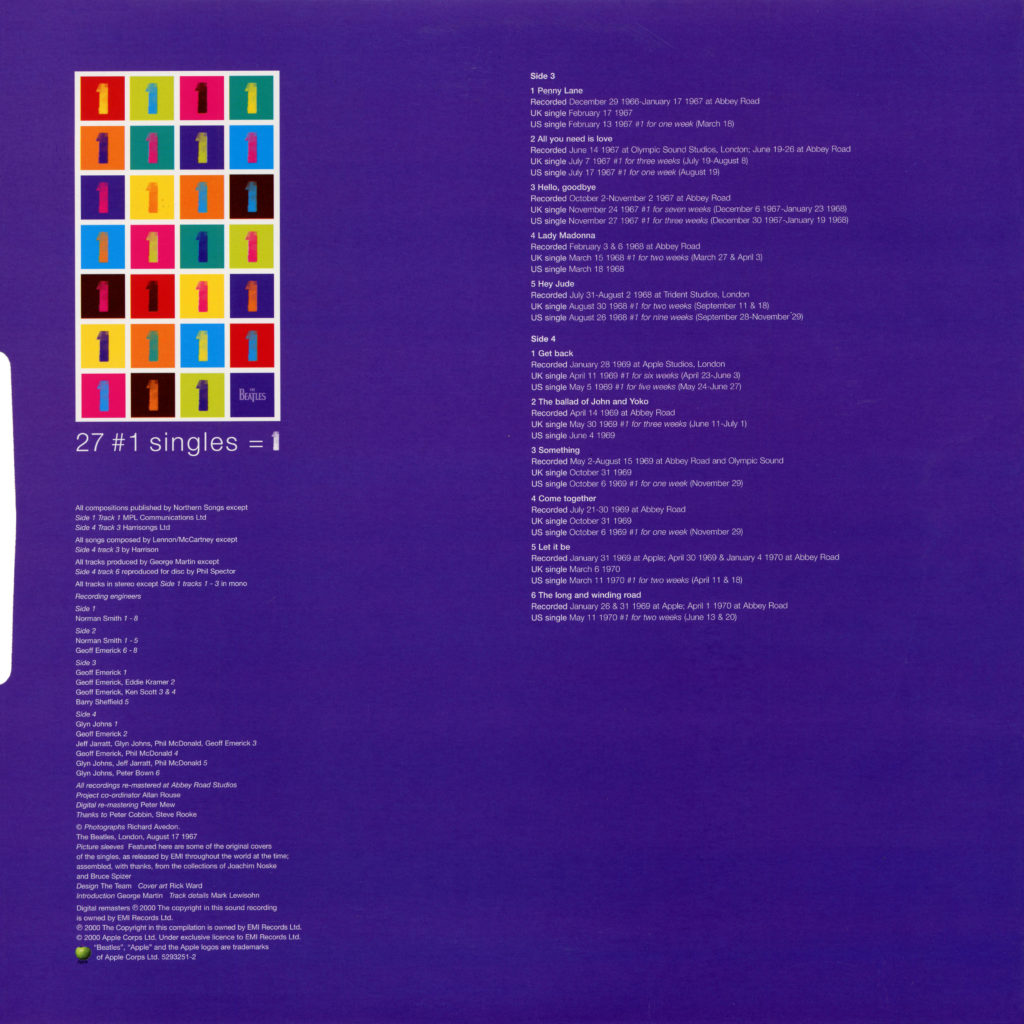
Records have red labels and perimeter prints with Apple logo on 3′ o’clock, and date 2000. On the 12′ o’clock there is number 7243 529325 1 1. Also on the 3′ o’clock there is serial numbers below numbers of sides. Matrix number variations:
Variation 1: early matrix numbers: side 1: 5293251 3A1 SRz (scratched with error: 5 instead of 6); side 2: 5293261 B-01-1-3 (stamped) SRz (scratched); side 3: 5293271 A-02-1-3 (stamped); side 4: 5293271 B-01-1-3 (stamped) SRz (scratched).
More correctly, numbers stamped and SRz scratched:
Variation 2: 5293261 A-01-1-3 SRz / 5293261 B-01-1-2 SRz / 5293271 A-02-1-2 / 5293271 B-01-2 SRz.
Variation 3: 5293261 A-01-1-3 SRz / 5293261 B-01-1-3 SRz / 5293271 A-02-1-2 / 5293271 B-01-1-2 SRz.
Variation 4: 5293261 A-01-1-3 SRz / 5293261 B-01-1-3 SRz / 5293271 A-02-1-2 / 5293271 B-01-1-2 SRz.
In addition, 100 last special copies of the “1” was manufactured at the Hayes, EMI UK. This certifies that this item is among the last 100 copies ever pressed at the EMI manufacturing plant on January 8th 2001 and bears the unique matrix numbers: 5293261 A-100 / 5293261 B-100 & 5293271 A-100 / 5293271 B-100. A very rare item was given only to selected EMI & manufacturing plant employees. For each copy of the attached certificate of authenticity signed by Alan McElroy, Senior Manufacturing Director, EMI Music.
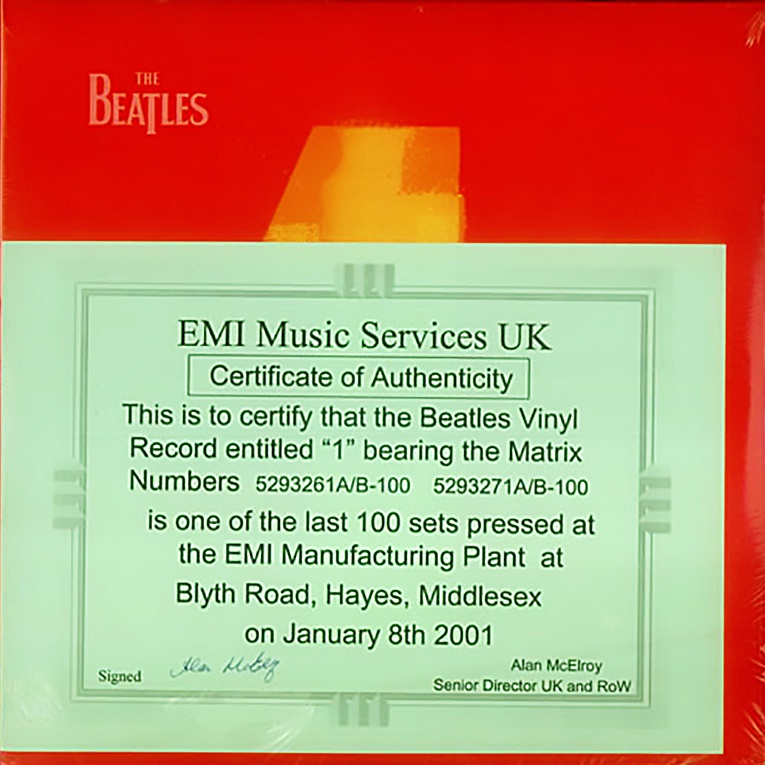
This records was manufactured by Hayes, EMI UK.
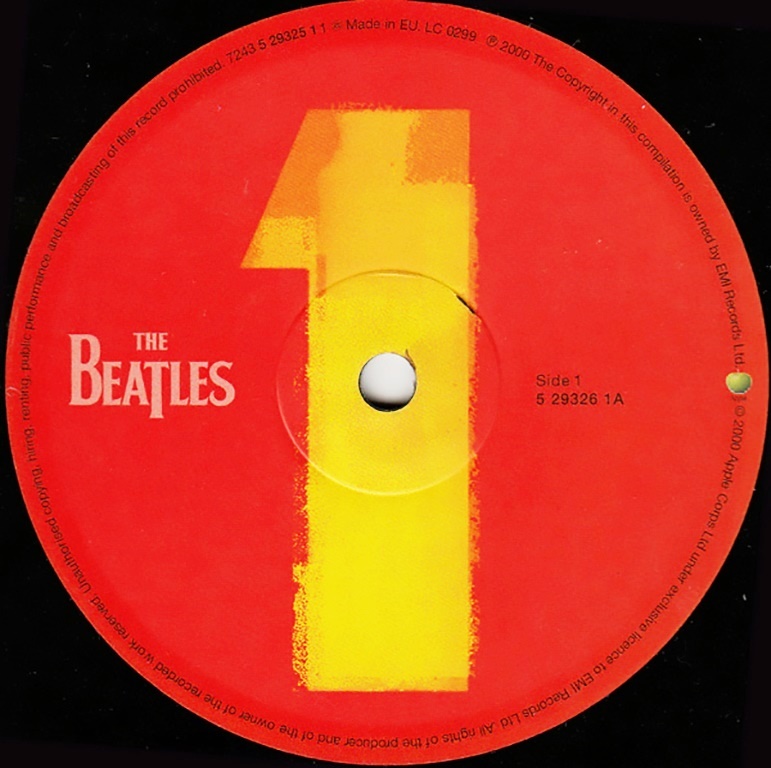
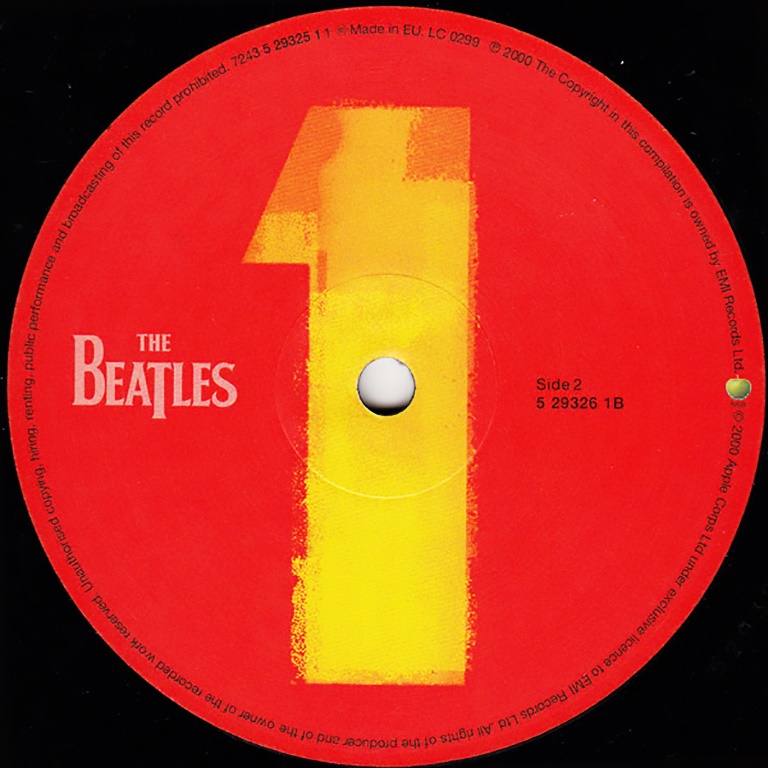
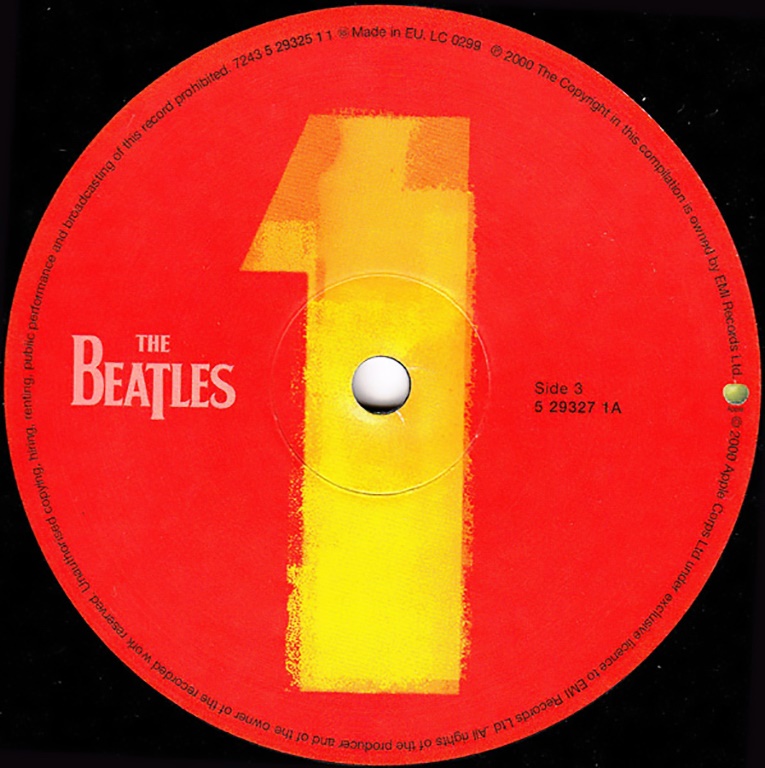
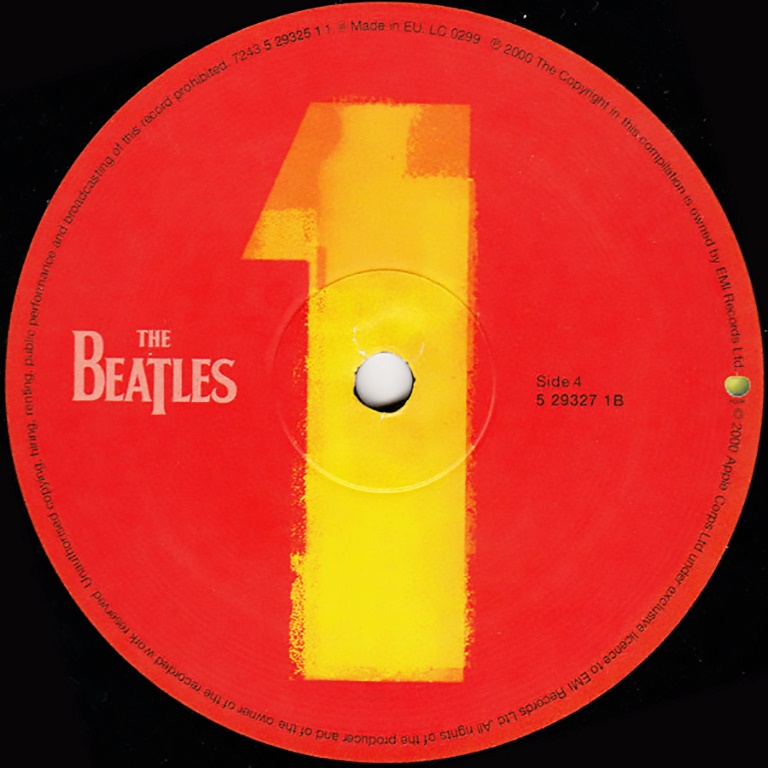
Records pressed by EMI Records, Uden, Netherlands.
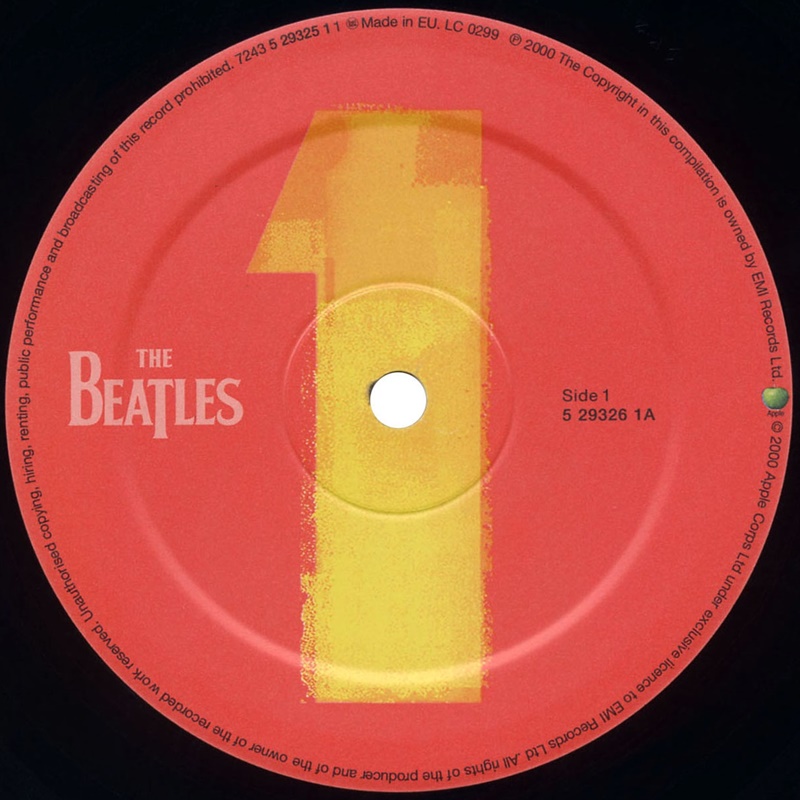
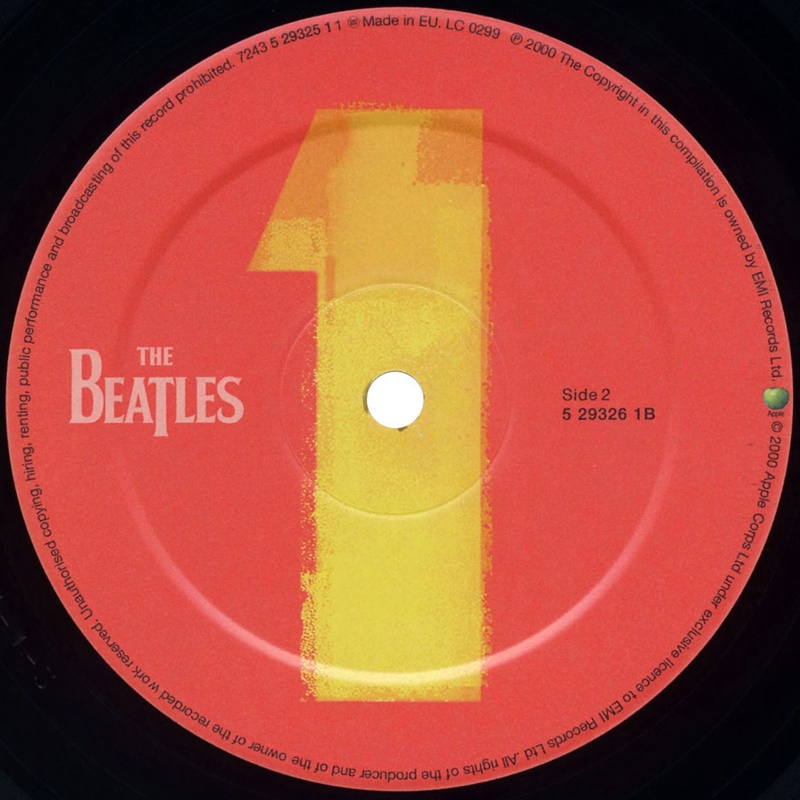

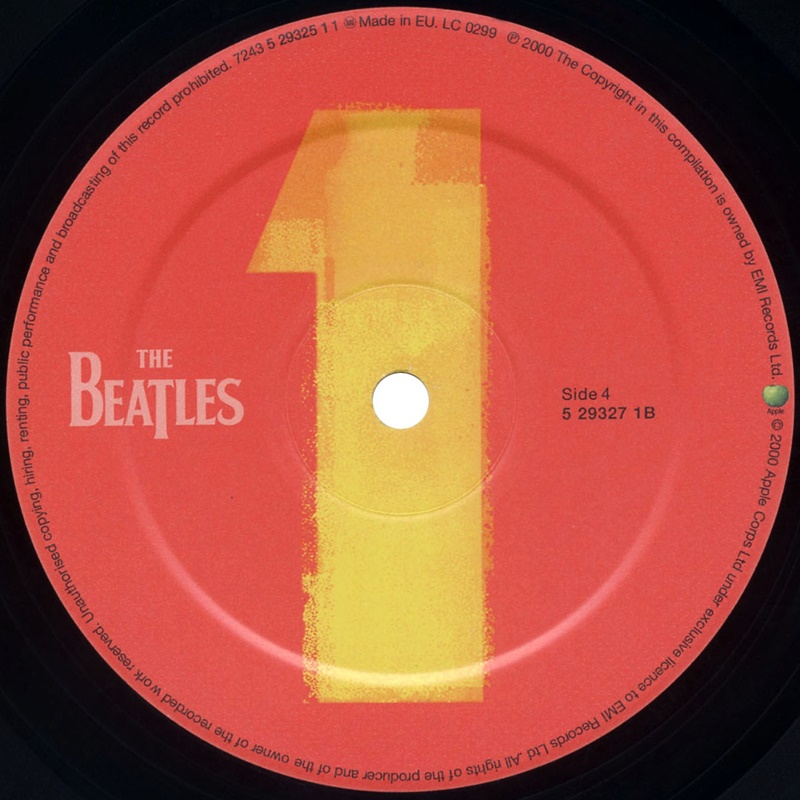
Second pressing, release: December 4, 2014. Apple – Universal 0602537600793. At this time, for the album were used recordings remastered in 2009. Gatefold sleeve with Apple and Universal logos on back side. Text: “Didital Remasters 2009… 2014 Apple Corps. Ltd… 0602537600793”. The album included the four celebrated portraits of the group by photographer Richard Avedon and a 24″ by 36″ poster of 126 different singles picture sleeves. Records was housed in a original pictures inner sleeves with cut-out on the back sides.
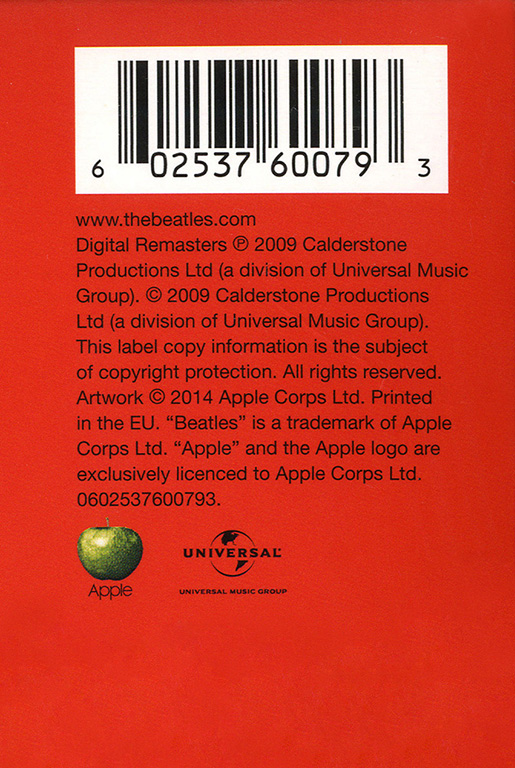
On the shrink wrap appeared yellow sticker with red print “The Beatles 27 Classic No. 1 Singles”.

Records have red labels and very small perimeter prints with Apple logo on 3 o’clock. Serial number, year of publication and year of remastering appeared in perimeter print. Vinyl pressed by Optimal Media GmbH, Germany.
Matrix numbers: Side 1: 11142 1 (or 2A) 00602537600793000000; Side 2: 11142 1 00602537600793000000; Side 3: 11142 1 00602537600793000000; Side 4: 11142 1D 00602537600793000000.




Third pressing, release: November 6, 2015. Apple – Universal 0602547567901. The remastering was overseen by Giles Martin, the son of esteemed Beatles producer George Martin.
Sound engineer Miles Showell joined Abbey Road Studios from Metropolis Mastering in 2013. He controlled 1/2 speed mastering for the “1”, when analog source was played back at half speed and the cutting lathe is also run at half speed while cutting the lacquer.
Gatefold sleeve with Apple and Universal logos on back side. Text: “…2015 Apple Corps. Ltd… …Made In Germany. 0602547597901. Universal International Music…, Netherlands”. The album included the four celebrated portraits of the group by photographer Richard Avedon and a 24″ by 36″ poster of 126 different singles picture sleeves. Records was housed in a original pictures inner sleeves with cut-out on the back sides. Vinyl pressed by Optimal Media GmbH, Germany.
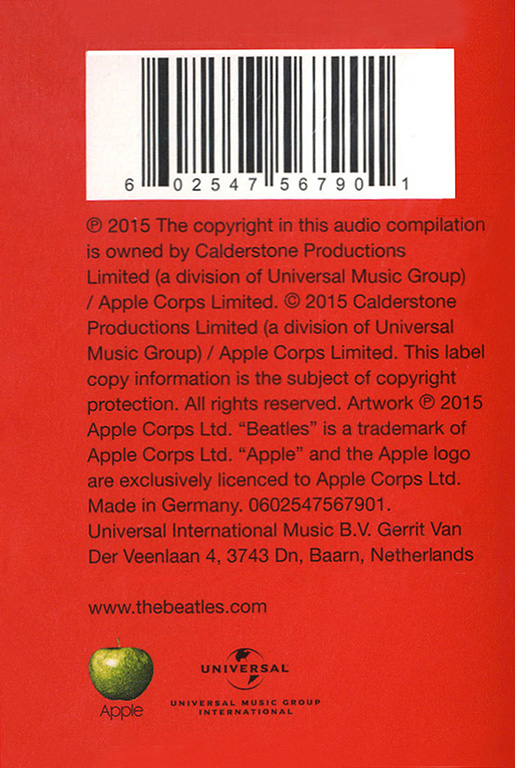
Records have red labels and micro perimeter prints with Apple and Universal logos on 3′ o’clock. Serial number and year of publication appeared in perimeter print.
Miles Showell, who controlled Abbey Road’s 1/2 speed mastering. His name appears in the matrix numbers: Side 1: 47567956 MILES ABBEY ROAD ½ SPEED BF06330-01 A2; Side 2: 47567949 BF06330-01 B1 MILES ABBEY ROAD ½ SPEED; Side 3: 47567956 BF06330-02 C1 ABBEY ROAD ½ SPEED; Side 4: 47567956 MILES AR ½ SPEEDÂ BF06330-02 D1 STAN RICKER R.I.P. & THANK YOU.
“Stan Ricker R.I.P. & Thank You” – This inscription appeared in memory of the legendary mastering and recording engineer Stan Ricker which the passed away in June 2015. Ricker first made his mastering presence known as a disc cutter along with Jack Hunt, for the original Mobile Fidelity 1/2 speed mastered LPs released in the 1970s and 1980s. Ricker mastered the original Mo-Fi Beatles box set in the early ’80s. Stan Ricker belongs to the Hollywood Sapphire Group, and formerly was a member of the Audio Engineering Society. He was voted “Disk Cutting Engineer of the Year” in 1981 by “Playboy Readers Poll” and was voted “Recording Engineer of the Year” in 1984.”




P.S. Comparison of spines of these three editions (down to up): 2000, 2014, 2015.




















































































 RDF URL
RDF URL